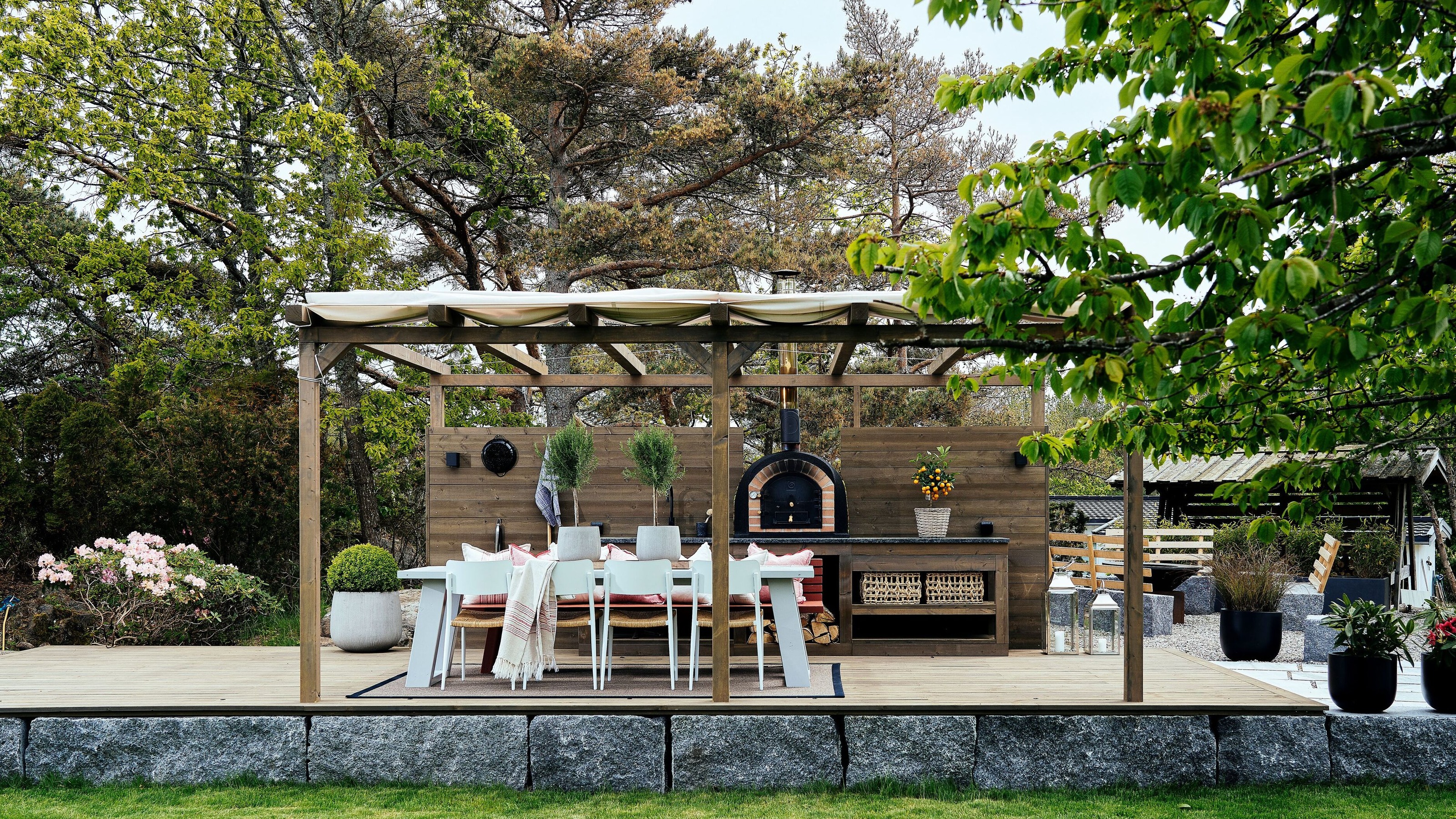
There's no shortage of modern garden ideas. Inspiration for outdoor spaces is all around us — and we're grateful for it. The hardest part is deciding which design route to pick.
If you're considering some new backyard ideas for the summer and are yet to decide on a plan, our garden designers and landscape experts can guide you to the best choices for your space.
There's no point settling on a particular scheme if you're not going to have time to maintain it. Especially if there is another one that might suit you, your garden's conditions, and your lifestyle better.
1. Go for a Nordic Theme
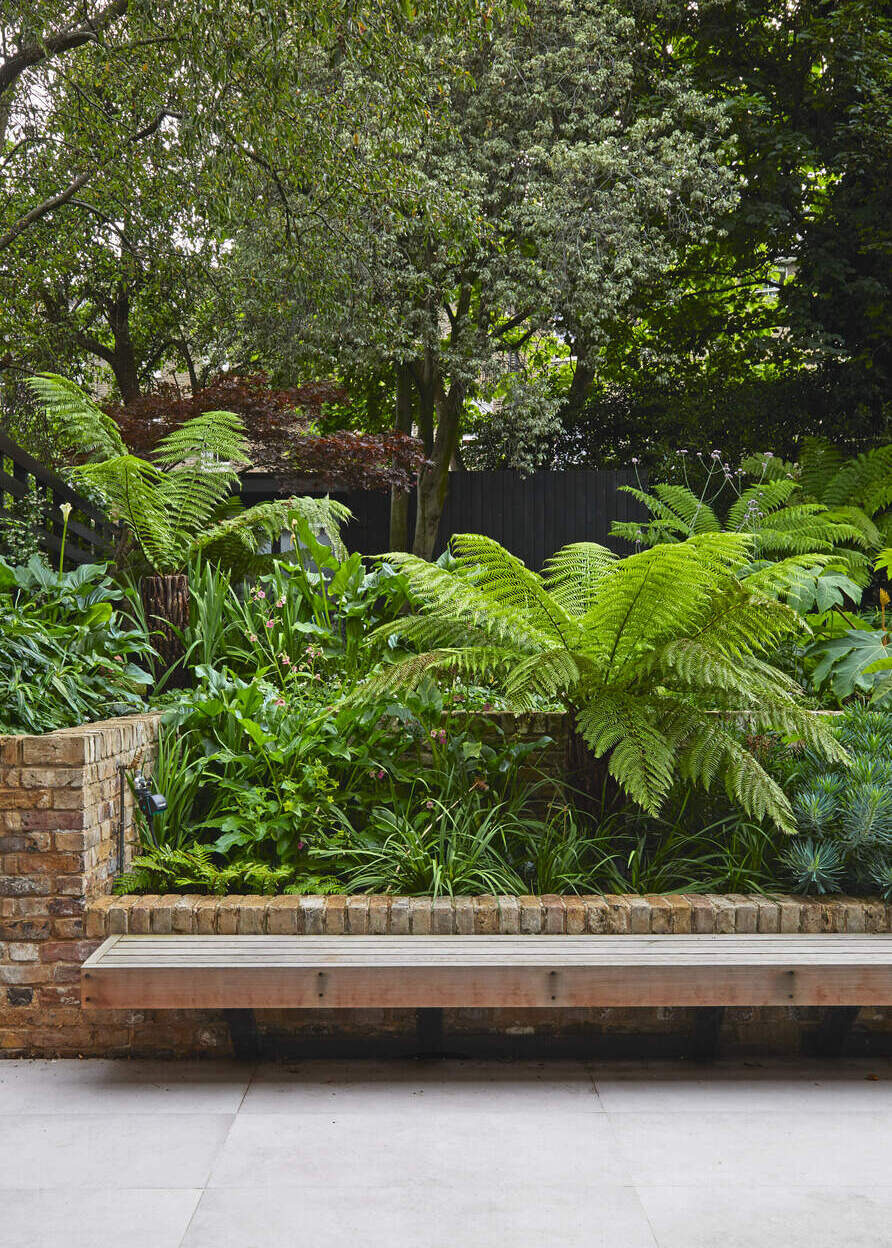
Love modern Scandinavian design? Why not extend this simple yet beautiful aesthetic into your garden? Much like with interiors, in the garden this style is calming, restrained, and effortlessly cool with earthy, robust materials, and a subtle planting scheme that's suited to a temperate climate.
"With warm natural tones, textural planting and ethereal calm, the Nordic garden is a new and increasingly popular theme for us at Dig," explains Alexandra Hollingsworth, garden design and co-founder, Dig "The color palette is bronze, green, white and burgundy, with floral interest coming from small subtle clusters, rather than large blooms.
"This theme is particularly suited to the clean lines of modern architecture, and can be easily adapted for sun and shade. Plants such as ferns, tiarella, stipa, thalictrum all provide movement and texture, with the anchoring of shrubs like Pinus mugo. The look is elegant, understated, and contemporary, and works well with rusted Corten detailing."
This Fern Collection consists of 5 easy to grow decorative fern varieties, each individually selected from a range of different varieties to create a special feature in your garden that combines form, color and texture. Each plant is supplied in an approximately 1 liter containers.
2. Create a Mediterranean Haven

Want to evoke vacation vibes in your own backyard? If it's a sun trap, consider Mediterranean garden ideas, with scorched earth tones for your patio tiling and terracotta pots filled with drought-tolerant plants, such as lavender, sedum, and rosemary. If you live in an arid zone, swap a thirsty lawn for water-wise gravel landscaping instead.
"This theme can flex with clever use of plants, but it is, of course, most at home in a sunny space," says Alexandra. "Country gardens with loose landscaping, such as gravel paths, boulders, and rustic pergolas, work well with this theme on a more expansive scale, using trees like olive, cypress, and pine.
"However, we do a lot of small urban Mediterranean gardens, especially to be enjoyed in the evening after work. Aromatic, evergreen and flowering shrubs like Rosmarinus ‘Miss Jessop’s Upright’, and Choisya ternata ‘Scented Gem’ are hard-working plants that earn their keep in a smaller space."
3. Consider a Tropical Oasis
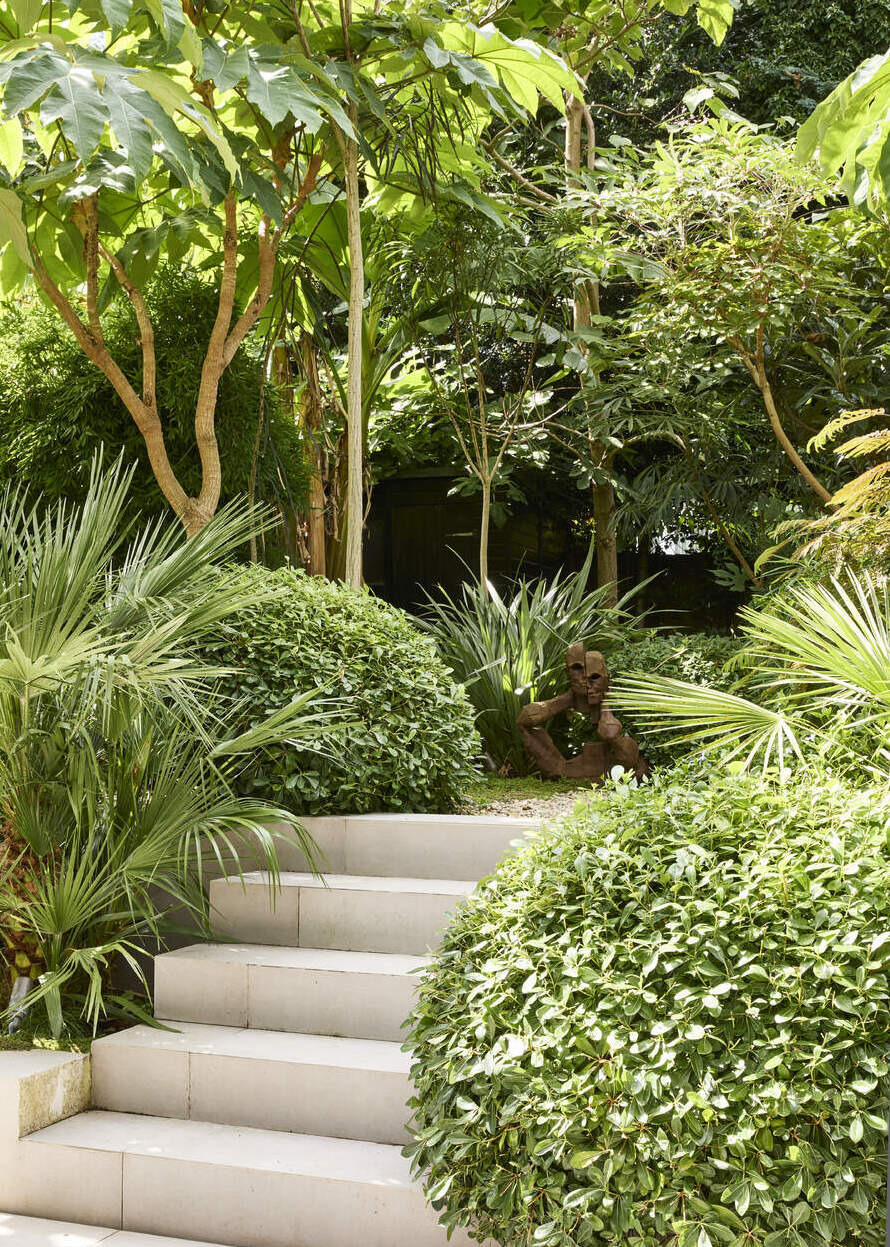
Rather than subtle and soothing or attractively arid, perhaps you fancy a lush landscape? In which case, a tropical garden style could suit. This type of garden requires incorporating layers of large-leaved plants, such as palm trees and ferns. Lean more towards foliage than flowers, with understory and groundcover layers beneath a taller canopy.
Consider Fatsia Japonica too — like this Fatsia Japonica plant on Gardening Express — a popular evergreen that grows best in moist, well-drained soil in a sheltered spot with a mix of full sun and partial shade, although it can tolerate full shade too.
"This is a bold choice, especially in places where it is not a classically native look, or one traditionally associated with the local architectural vernacular," says Alexandra. "The interest comes from large, bold leaf shapes, contrasting forms and textures rather than flowers.
"A jungle theme does well with little sun, as ferns and fatsias are shade lovers, but it can be adapted for sunnier spots. This theme looks wonderful with modern architecture in an urban environment, but can work in a rural setting as well. A visit to the subtropical and jungle gardens of Cornwall, such as the Lost Gardens of Heligan, can provide plenty of inspiration for this."
4. Design for Wellness

Booking a spa retreat to relax won't be necessary when you design a space for wellness in your backyard. What you include could be as elaborate as a sauna room, plunge pool, and gym, or as simple as a yoga platform and a quiet place to meditate.
"Hot tubs offer a great way to bring a small group of friends together to relax and socialize," says Manoj Malde, garden designer and author, Your Outdoor Room. "They come in different styles and sizes, and range from inflatable types, that you can store inside in winter, to beautiful wood-clad, stone-heated pools.
"If budget and space allow, you could even consider an outdoor sauna cabin or barrel — add a deck around it and you also have a great place to throw down a yoga mat and do a downward dog."
"The intent of a modern wellness garden is to help support mental clarity and emotional balance," says New York-based landscape designer Kat Aul Cervoni, founder, Staghorn Living. "It encourages daily connection with nature — even if it’s just five minutes in the morning with a cup of coffee.
"These gardens are designed to engage the senses in a calming way by using soft textures, soothing scents (like lavender or thyme), and gentle movement from grasses or wind chimes to create a space that helps you slow down and breathe deeper.
"Whether it's a tucked-away bench, a meditative planting palette, or a path for barefoot grounding, a wellness garden is all about designing for restoration. I like to use a simplified plant palette and use repetition and soft, layered textures to create a calming rhythm. Lots of greens, a bit of white, and maybe a little lavender.
"The idea is to use colors and textures that have a calming effect rather than an energizing effect. Natural materials: gravel, wood, water, and stone all contribute to a grounded, sensory experience, too.
"A 'destination' within the space is recommended — I love placing a chair in dappled shade, or even adding a hammock, or a low platform for yoga or meditation."
5. Opt for Effortless Entertaining
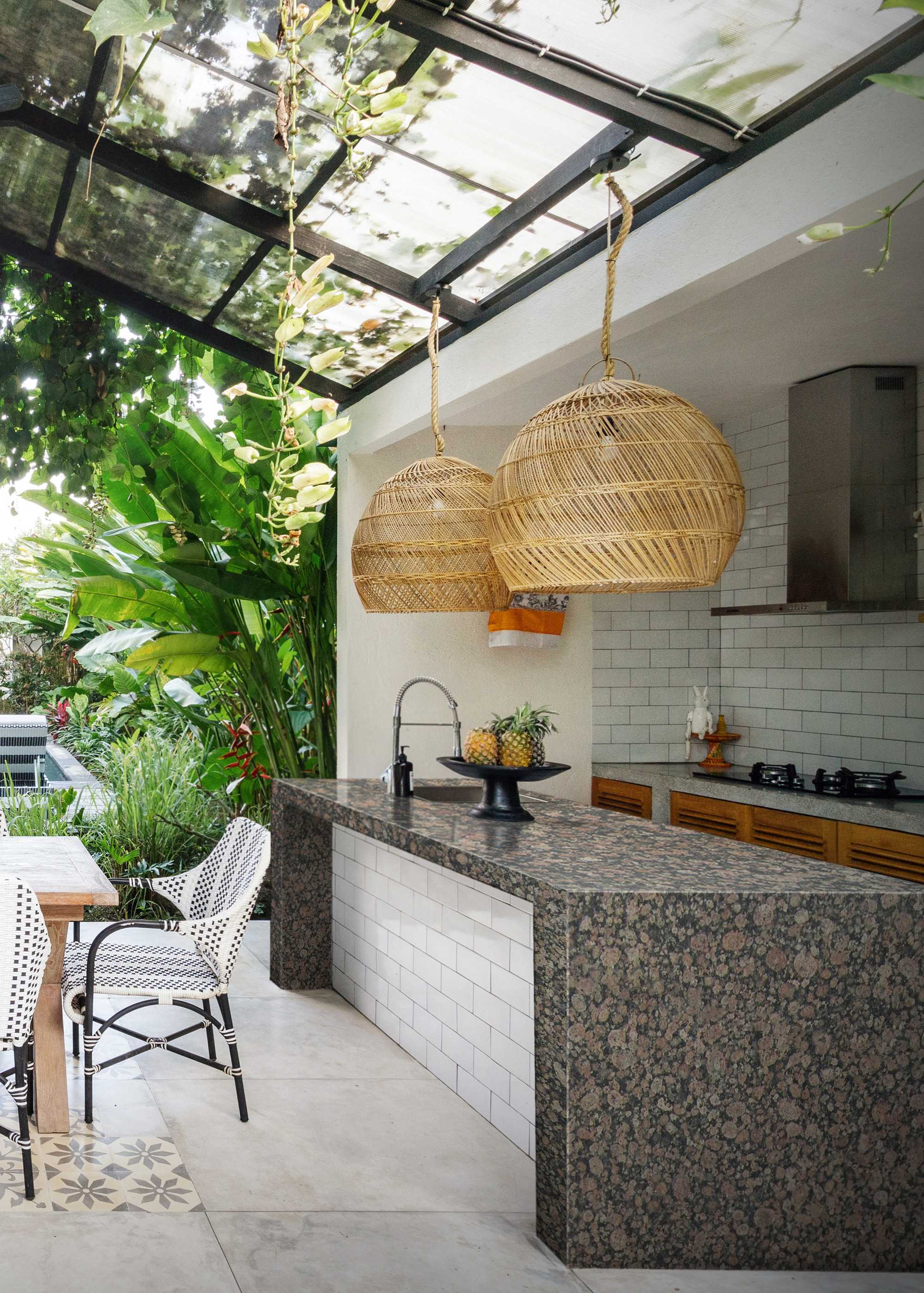
Home entertaining is a popular pastime, particularly during the summer months, when we can take the party outside. However, to make it effortless requires a considered garden setup.
Depending on your budget, where you live, and the amount of time you can actually spend entertaining outdoors due to weather conditions, this may be as simple as a pizza oven and outdoor dining area, or as elaborate as a fully-functioning outdoor kitchen.
"A well-planned outdoor kitchen should flow effortlessly into dining and entertaining zones to create a cohesive outdoor living space," says Steve Esdaile, founder, EO Outdoor Kitchens. "Consider how guests will move between the cooking, dining, and lounge areas. Positioning the kitchen near a patio or decking, where people naturally gather, encourages conversation and engagement.
"Striking the right balance between sunlight and shade will also improve the comfort and usability of your outdoor kitchen. Observing the sun's movement throughout the day will help you determine the most suitable spot. Consider integrating shade structures, such as pergolas, awnings, or strategically located trees."
6. Choose Native Planting
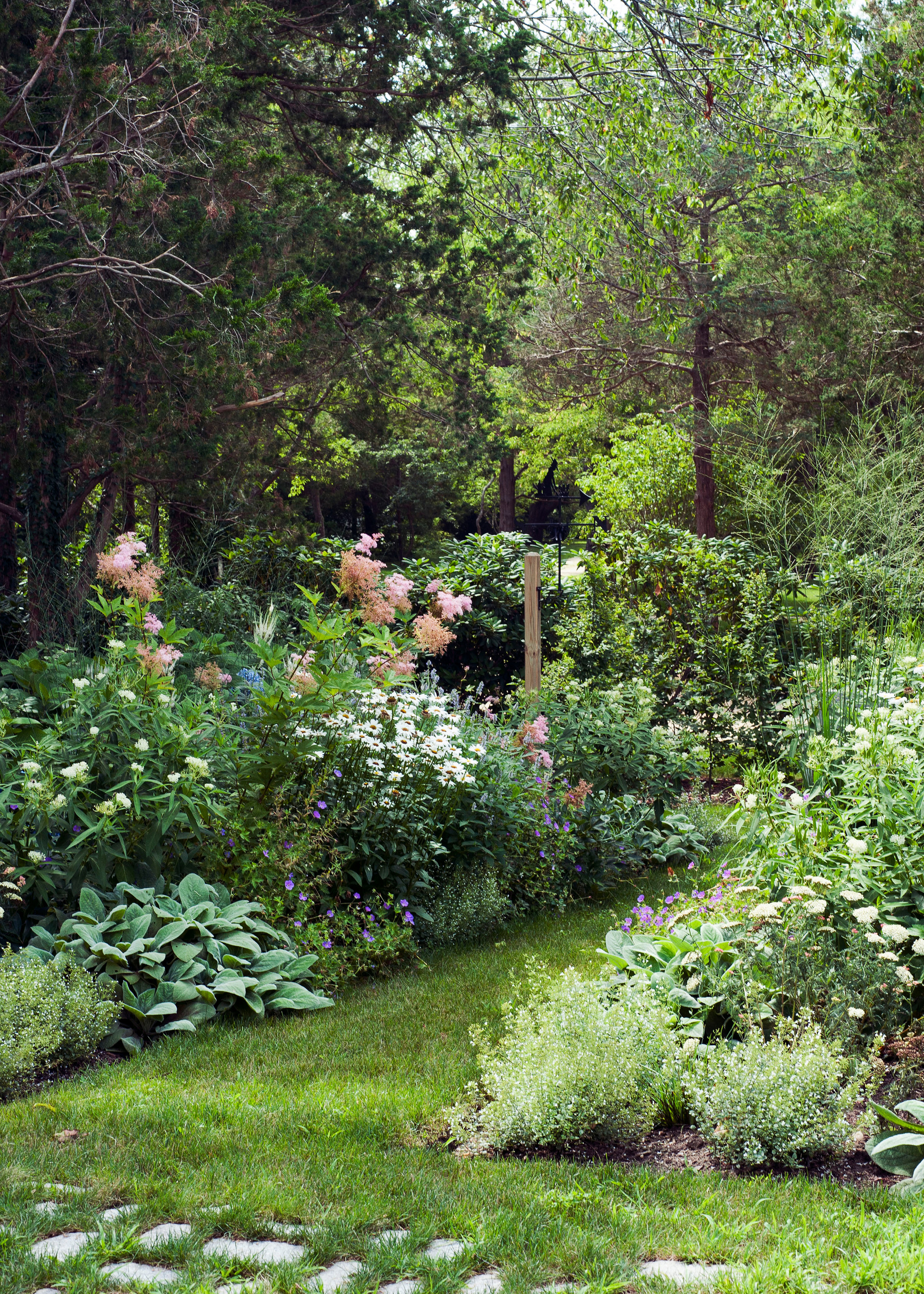
The idea with native planting is to choose plants that are adapted to your region and have grown there in the wild for centuries, rather than those introduced more recently, which can become invasive and problematic. As well as being beautiful and ecologically beneficial, this approach also works well if you prefer low-maintenance garden ideas, as these plants tend to look after themselves and require less watering.
"I’m so delighted that using native and climate-resilient plantings is in the gardening zeitgeist now; it’s a wonderful approach for creating a modern garden," says Kat.
"Not only do native plant gardens help to replenish plant communities, but they also support native pollinators, wildlife, and ecosystems. The bonus is that because these plants are adapted to the region and climate, they are also generally some of the toughest and most reliable plants, which can lead to higher success rates and slightly lower maintenance (although we still have to stay on top of weeding).
"When it comes to learning about which plants are native to your region, I like leaning on a few helpful online resources, such as the Lady Bird Johnsen Wildlife Center (part of the University of Texas in Austin) and the National Wildlife Federation.
"When choosing which native plants you want for your garden, first start by becoming fully familiar with your space’s light conditions — this will really be your guide to knowing what will succeed in your space.
"Beyond light conditions, think about seasonality and select a variety of plants that have varying bloom times (something for spring, something for early summer, late summer, and fall) — also known as successional planting. This keeps your garden looking dynamic and colorful throughout the year, and keeps a source of food available for pollinators as well."
7. Set the Scene for a Wildlife Haven
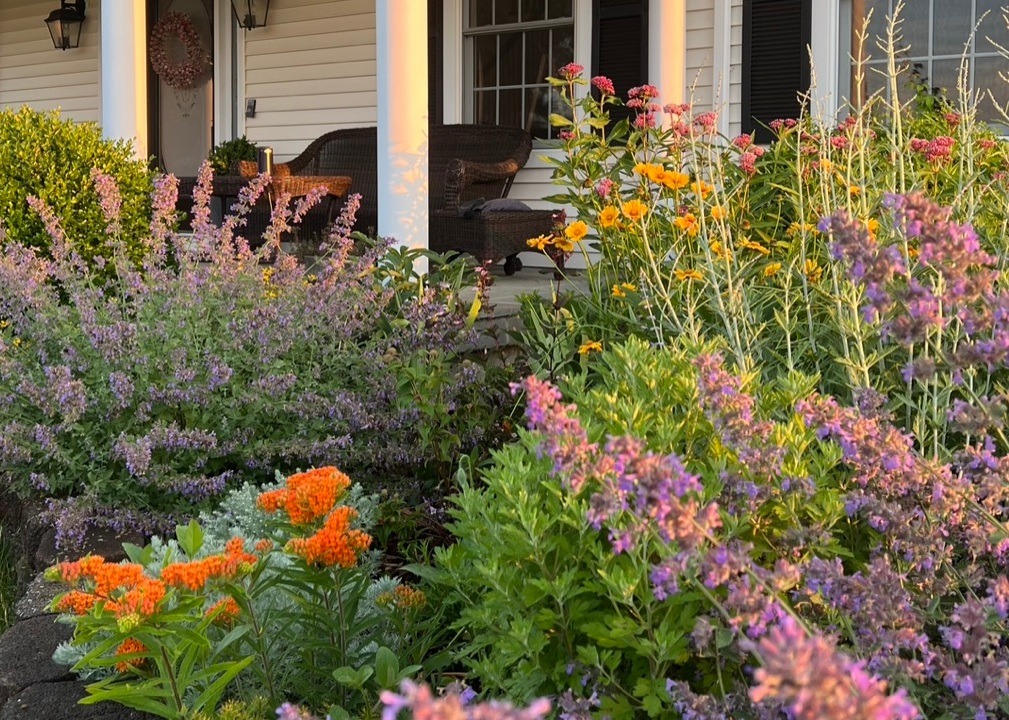
As we become more aware of how detrimental to nature some gardening practices can be (pesticides, herbicides, and manicured lawns, we're looking at you), garden trends are taking a different direction. This includes regenerative approaches and wildlife gardening, where nature is put front and center, working with it, rather than against it. So, instead of battling pests with poison, we encourage their predators with pollinating plants and allow nature to do the work itself to restore balance.
"In our gardens, wildlife can help to control pests, clean up detritus and feed the soil, leaving us more time to enjoy our little haven," says Manoj. "If you create the right conditions for wildlife, it will come.
"Encouraging pest predators, such as birds, frogs, bats, ladybirds, beetles, hoverflies, spiders, lacewings, and parasitic wasps into the garden will reduce the populations of slugs, aphids, and other pests. Lure them in with a diverse range of plants, which will also minimize space for weeds to grow if you plant them close together.
"Bees and other insects help to pollinate ornamentals and food crops, so they are great for the veggie patch and fruit trees. Our bee populations are declining, so you could help reverse this trend by installing a simple home for solitary bees, such as bricks designed with the right-sized holes — simply replace the bricks in a boundary wall. Or make or buy a bug hotel.
"Trees and hedges provide good habitats for birds. Also, introduce berries and other plants that provide nourishment and feed birds in the winter, when food is scarce. Water in the garden will also attract wildlife, from birds and bees to frogs, newts, bats, dragonflies, and damselflies." These water garden ideas will fill you with inspiration to attract our wild friends.
8. Introduce Edibles
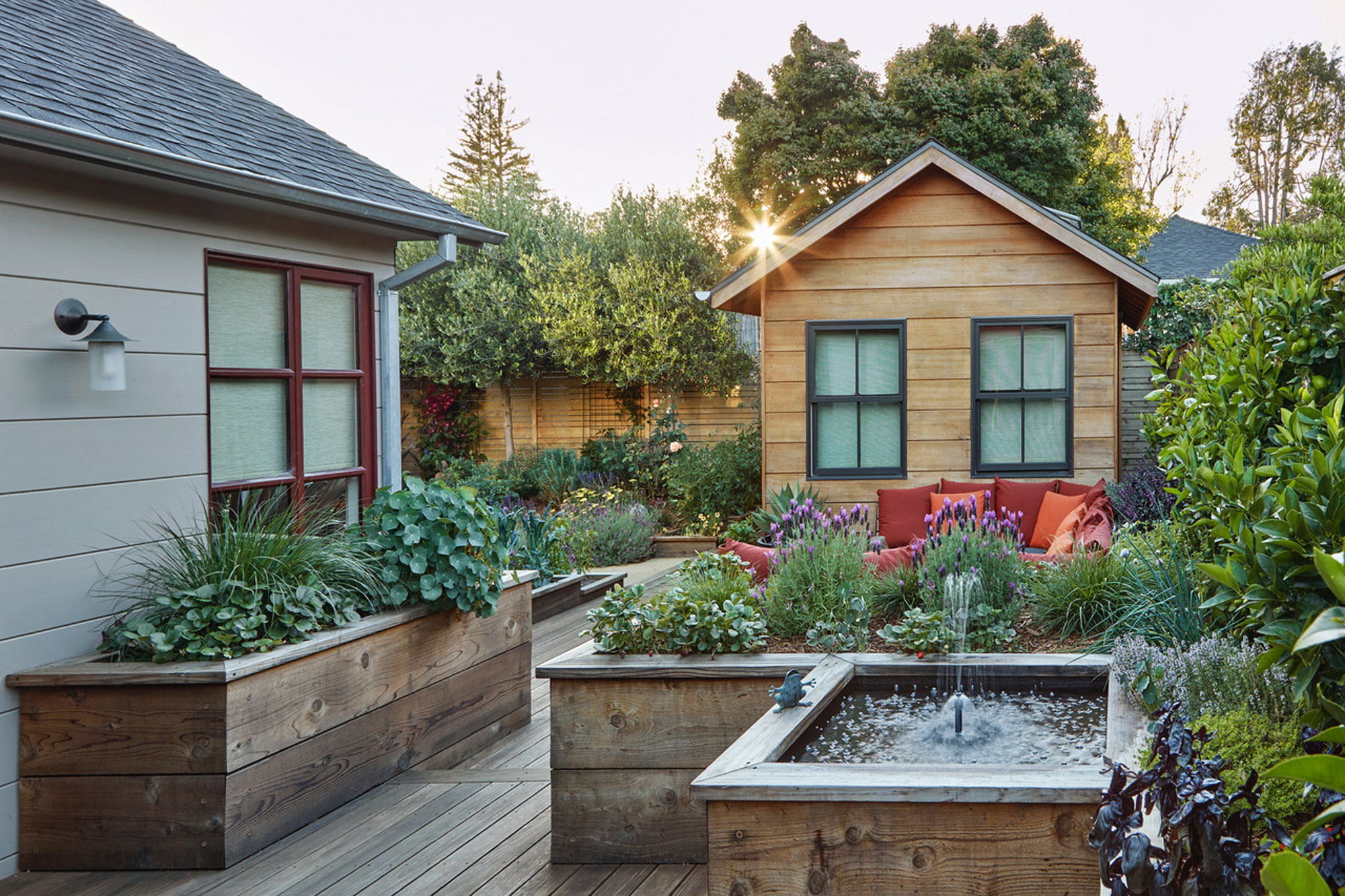
Growing fruit and vegetables in your backyard isn't exactly new, but a vegetable garden is firmly back in vogue. It spans all demographics, too.
"Nurturing some of your own homegrown organic fruits and vegetables is a tremendously positive action in the face of climate change," says gardener Kim Stoddart, author, The Climate Change Resilient Vegetable Garden. "In addition to saving money and putting food on the table, it reduces plastic and air miles.
"There are resilient growing options wherever you live, and you can carbon capture, repurpose waste, and boost biodiversity in the process, if you garden the climate-change savvy way."
9. Immerse Yourself in a Sensory Garden

With stress a significant factor in illness, sensory gardens have received much attention for their ability to induce a sense of calm and promote healing. But you don't have to be ill to benefit. Sensory gardens are a wonderful preventative measure and can be enjoyed just for the sheer pleasure of spending time in one. So what exactly is a sensory garden?
"While every garden has sensory qualities, a sensory garden is more than a lovely place to be," explains Dr Amy Wagenfeld, author, AHS Youth Sensory Gardening Manual. "A sensory garden is intentionally designed to enrich all eight sensory systems, rather than only the commonly known five basic senses: touch (tactile), taste (gustatory), smell (olfactory), sound (auditory), see (visual). To be an inclusive sensory garden, it also needs to provide experiences to enrich the three additional senses: body awareness in space (proprioception), balance (vestibular), and internal regulation (interoception).
"Designing for all eight senses is key to good sensory garden design. What to highlight is a highly personal choice and depends on one’s sensory preferences and tolerances for things such as texture, smell, color, sound, movement, and taste, as well as heartiness in your planting zone, and commitment to care for the plants and hardscape elements.
"Some people prefer quiet, low-smell sensory gardens, and others a more activating space with opportunities to move and be surrounded with bright, colorful plantings. The best kind of sensory garden accommodates a spectrum of sensory needs, deliberately designed quiet and alerting spaces.
"We want to nourish, rather than overwhelm, our eight senses in the garden. No matter whether a sensory garden is designed to be activating, calm, or a combination of both, it is very important to include shade, hydration sources, and places to sit to support internal regulation and keep us grounded.
"My top recommendation is to spend time thinking about your personal responses to sensation (all eight) and then to design the garden to meet your (or for whom the garden is intended) needs. Capitalize on what sensory experiences are most sought out and go for it. The other senses will be accommodated, just not as ‘up front and center'."
10. Set Up a Garden Bar
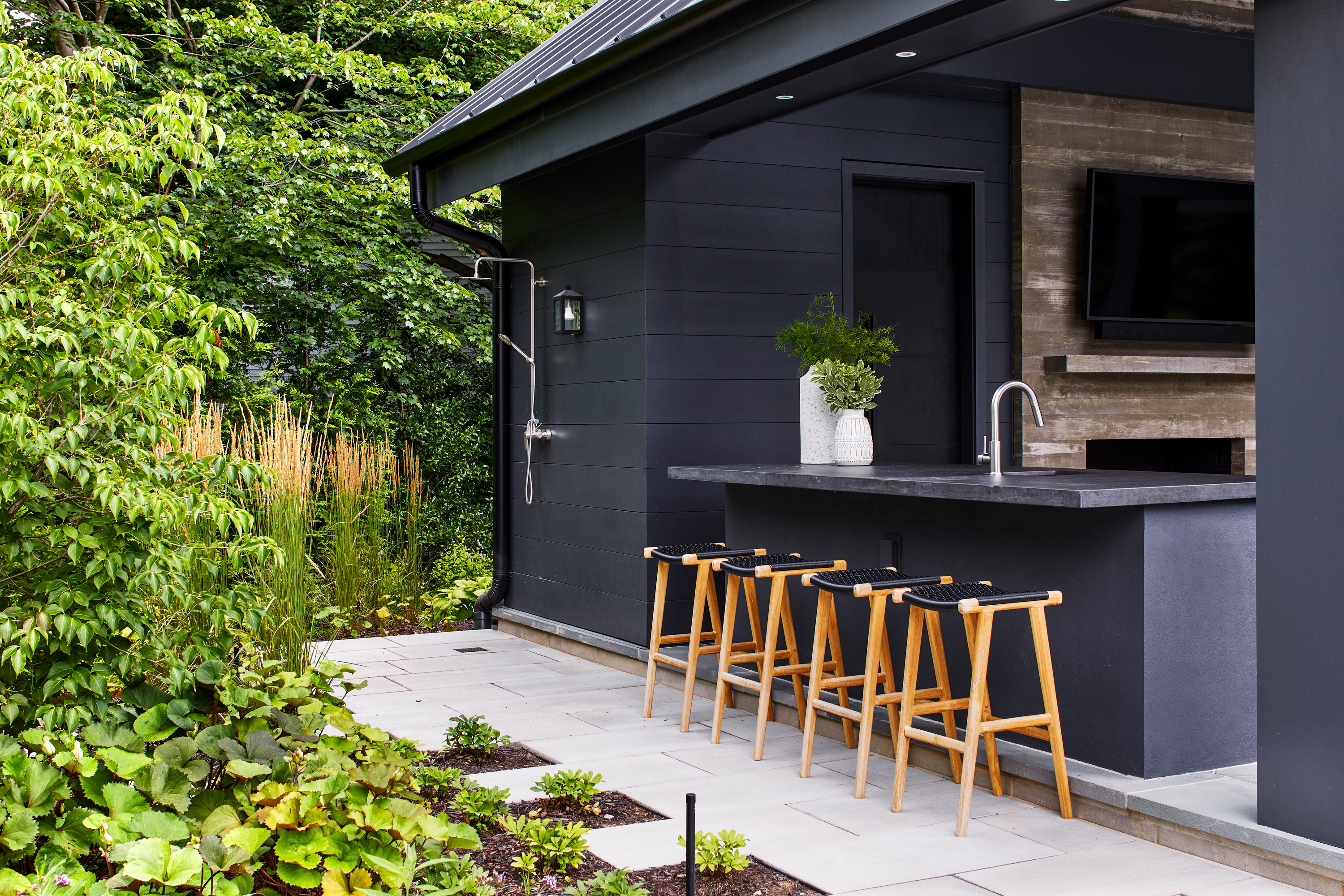
If you lack the space or budget for an outdoor kitchen or don't particularly enjoy cooking outside, a garden bar is a fun alternative. It makes inviting friends over for drinks much easier, and you don't have to worry about booking a babysitter.
"With more people entertaining at home, garden bars have become very popular," says Manoj. "They can be an extension of an outdoor kitchen, or you could turn an outdoor studio into a dedicated bar, rather like a pub at the bottom of your garden.
"Where space is more limited, consider a flip-down table attached to a wall, a few fold-up stools, and some wall shelves for glass and bottles."
A classic bar stool that is foldable — with a built-in safety lock so that it doesn't decide to fold at an inopportune moment — that is easy to store and with a footrest for added comfort.
11. Create Built-In Seating
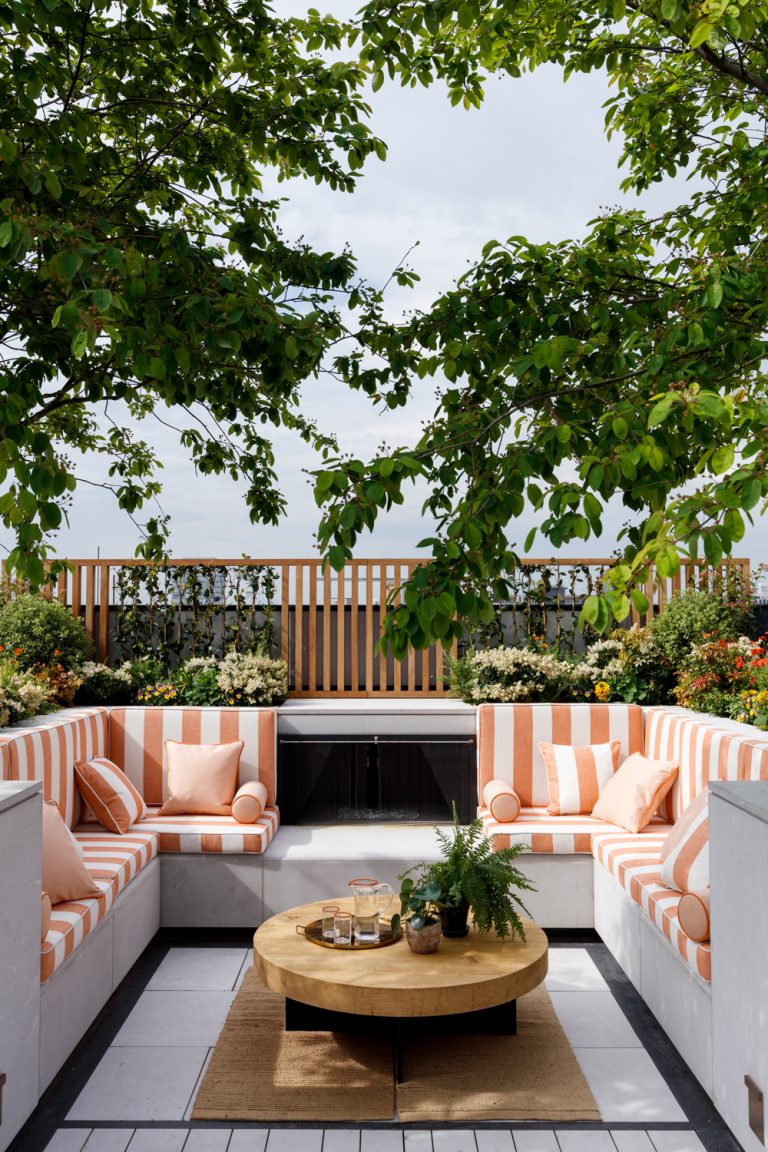
Built-in seating is the perfect way to add extra space to your modern garden. The ideal way to host and bring family and friends into one place, depending on whether you have a small garden or a bigger space, you can create built-in seating that suits you best.
This modern garden has perfectly incorporated striped outdoor furniture, a trend we've been seeing quite a bit this year, and we absolutely love it.
12. Opt For Floor Tiles
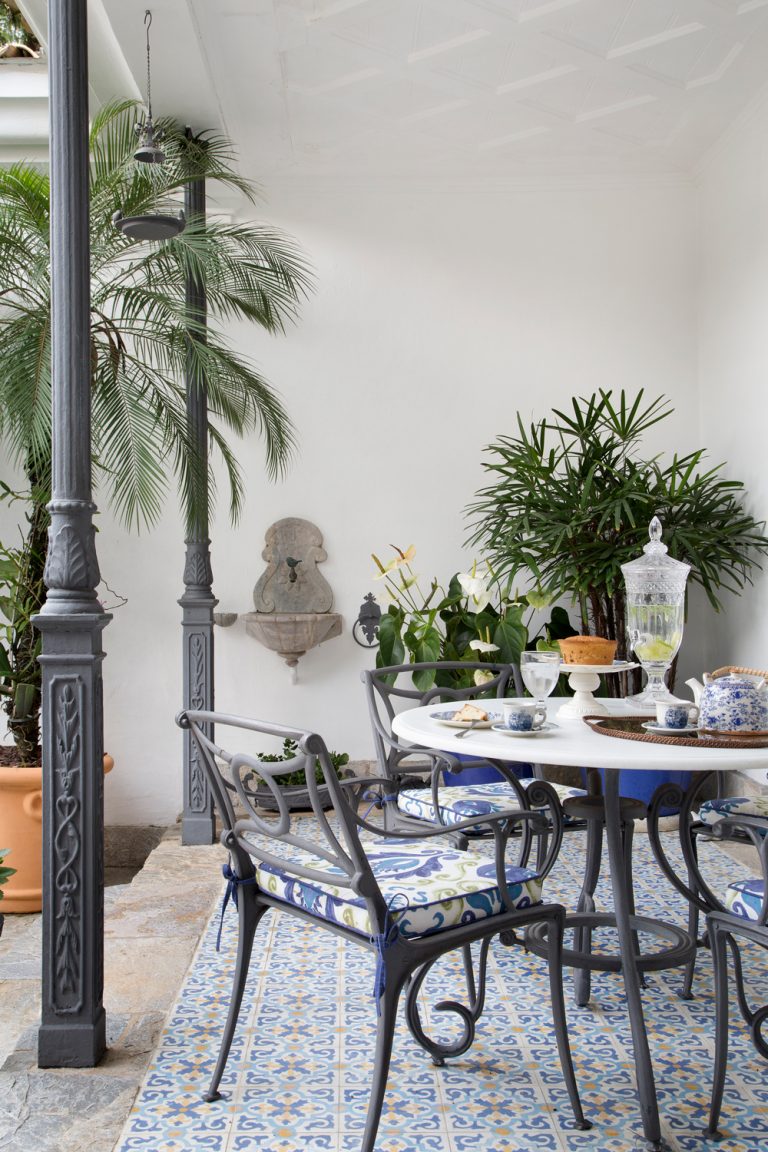
A big flooring trend we've been seeing take hold this year is outdoor tile floors. Why? Well, they bring a chic Mediterranean vibe to a space and certainly add flair to a once plain and simple modern garden.
Design studio Guta Louro has brought color and style to this patio with a simple and fresh look. A blend of colors — blue and white has a way of creating a calm and sophisticated ambiance.
In this modern garden, we also see the use of a sleek marble-top table and bright cushions that seamlessly match the flooring and further brighten up the space.
13. Or Wall Tiles
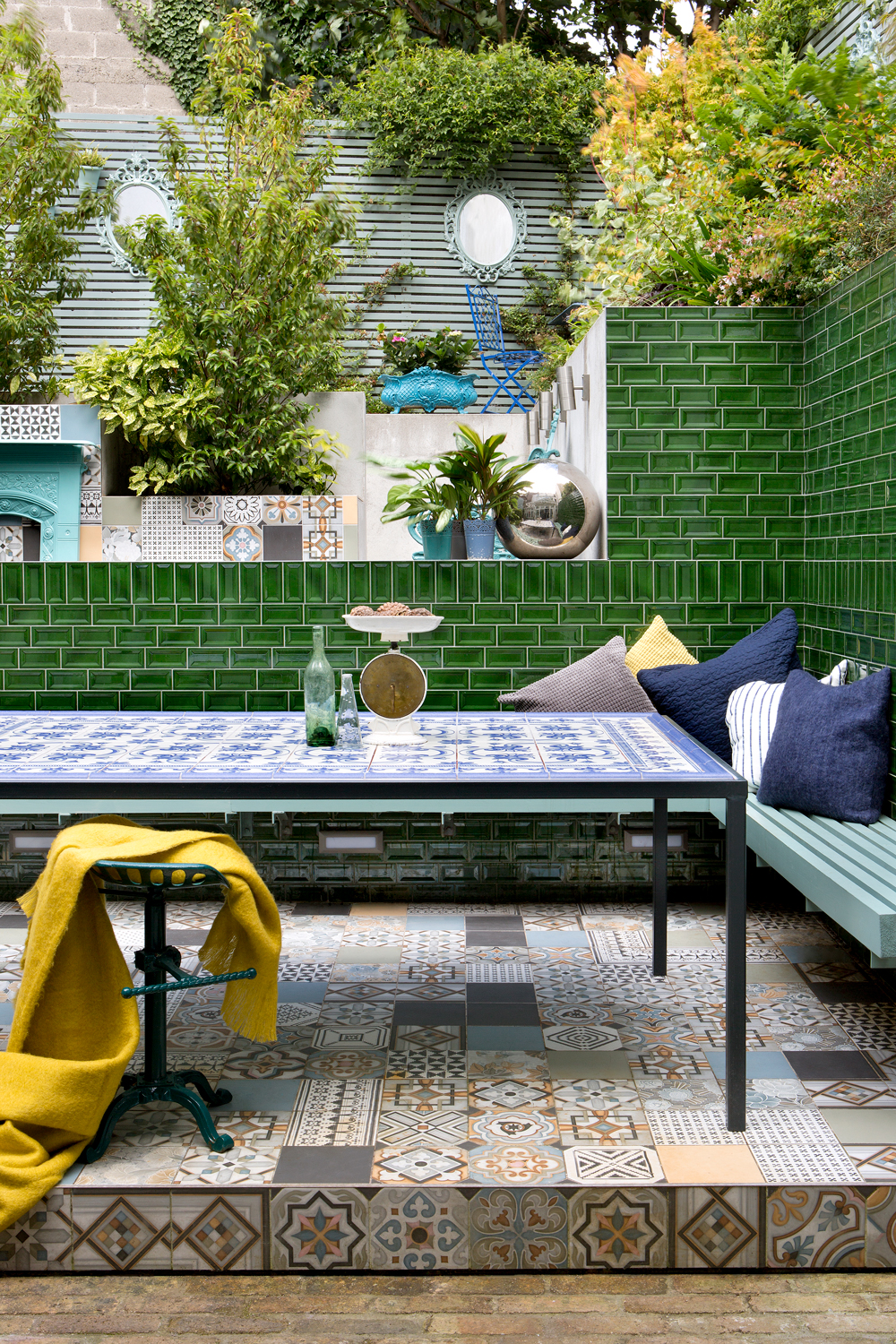
Using tiles on walls is a brilliant way to uplift your modern garden design by injecting color, texture, and interest into the space. too.
The metro tiled wall in the modern garden above offers a twist on traditional brick. With its layers of textured tiles and glossy finish, it’s a great example of how to mix colors and patterns, whatever the setting.
14. Paint Your Garden Wall a Bright Color

Adding a dose of bright color to your space can be as easy as a lick of paint and can work wonders to freshen up a space, while adding more joy and personality, even in the middle of winter.
"If you’re thinking of a quick garden makeover, even painting a single wall can make a big difference to freshen up the space," says Matthew Brown, paint expert at Sadolin and Sandtex. "When choosing the color, a good starting point is to consider the colors that already appear naturally in your space, such as tones of green. To highlight and accentuate these, consider using contrasting tones that will enhance the intensity of the natural hues."
"When space is at a premium, for example in a small courtyard, the use of a distinctive bold shade, such as a bright blue or warm orange, can enliven and energise a space, giving the perception of it appearing larger," says Matthew Brown. "If you like dark colors, don’t be afraid to use them. In a small space, dark shades can create a cosy, intimate atmosphere."
Deep colors can bring drama to outdoor spaces like this São Paolo patio garden (above) owned by set designer Michell Lott. The plum wall works brilliantly with the burgundies and purples of the plants, which include Euphorbia cotinifolia, dark philodendrons, begonias, and coleus.
15. Embrace Rewilding
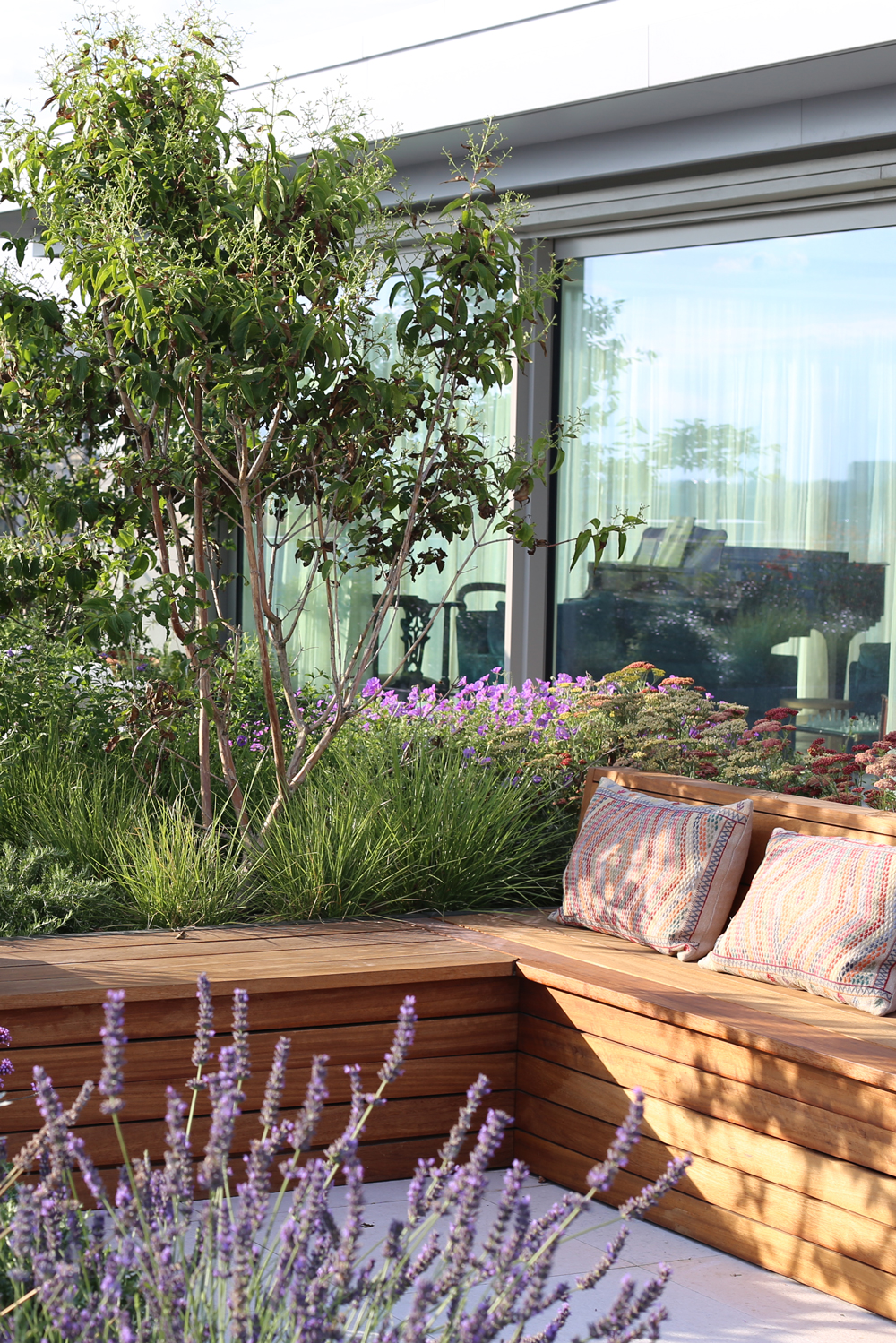
Could rewilding be a garden trend making a comeback in modern gardens this year? This elegant city roof garden, designed by Alastair Henderson of Aralia Garden Design, features a naturalistic tone, with the space thriving with plants along its borders and around the garden furniture.
This modern garden is filled with numerous blooms, including osmanthus hedging and several trees, such as Amelanchier. The space is also filled with small olives and multi-stem heptacodium trees. A true welcoming of several natural beauties that thrive and grow during different seasons throughout the year.
16. Install Spotlights or Uplights to Highlight Your Modern Garden
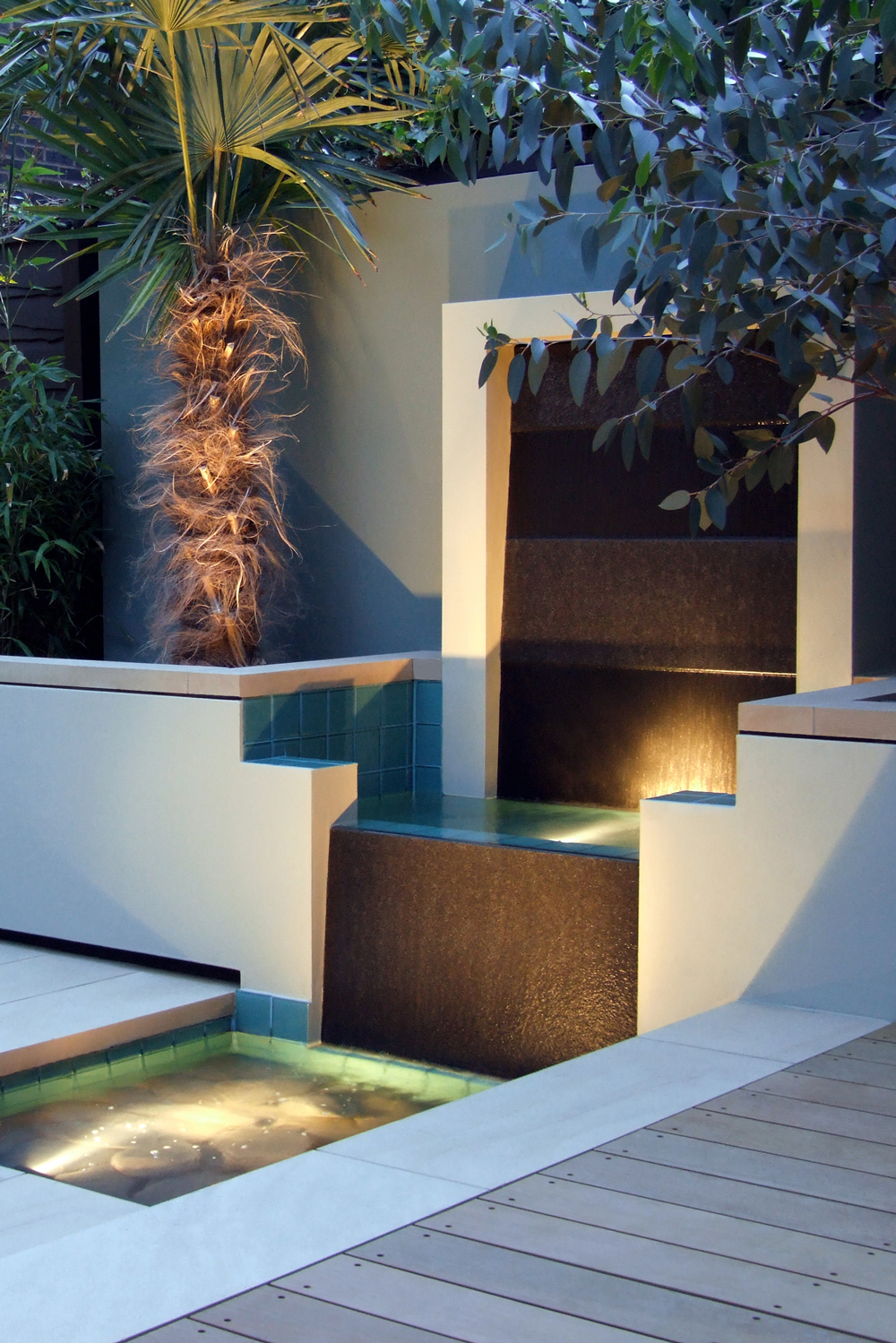
In this small urban garden, spotlights have been used to highlight certain aspects of the space, including a stunning water feature and a tree that enhances the overall look of the space — an excellent garden lighting idea.
Designer Amir Schlezinger from My Landscapes used spotlights to create dramatic shadows within the mini water fall. It's a seamless design that draws attention to what will soon become the focal point of the entire space.
"Spotlights are a great way of showing off a feature in your garden," says Brett Lockwood of The Outdoor Look. "This could be anything from highlighting a sculpture, plants, or a tree."
Brett continues: "Spotlights vary in light strength, so make sure you decide what effect you want from your lighting before you choose. For a calming effect, try a series of smaller, softer spotlights around the edge of your garden or patio. Or, for a more dramatic effect, you could go for a single, brighter spotlight to add some drama."
17. Think About Planting Vertically
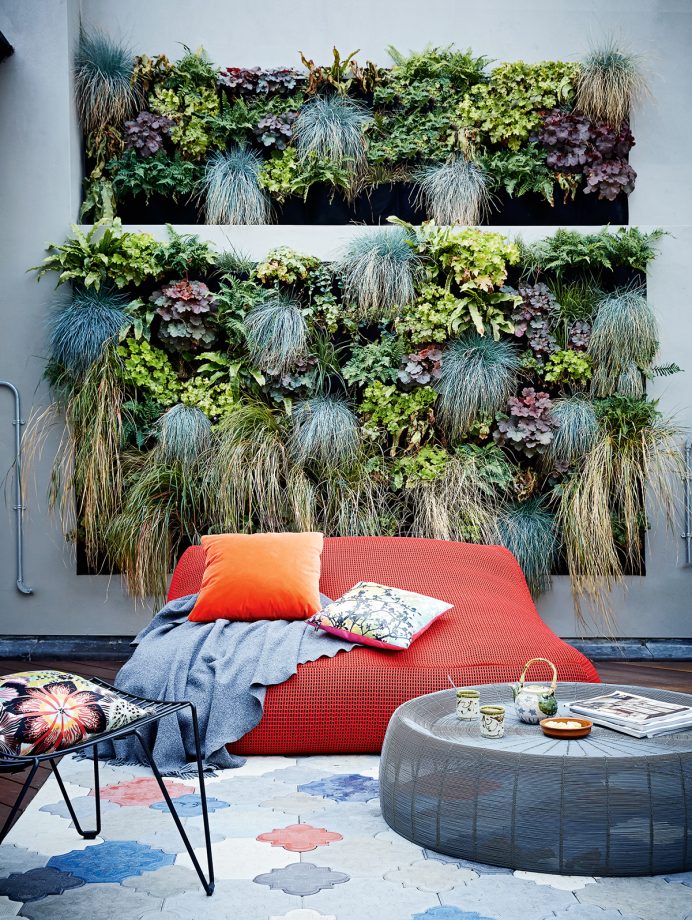
Want to make a statement in your modern garden? Then why not opt for a living wall? Living walls are a great way to add beauty and nature to an outdoor area of a home.
We often see plants placed around borders and flowerbeds, but taking things to the next level and embracing a living wall is a great way to enhance the space and create an edgy, chic feel.
The color combos in this design, with the pop of greens, red, and orange, create a warm and welcoming atmosphere.
18. Blur the Lines Between Indoors and Outdoors
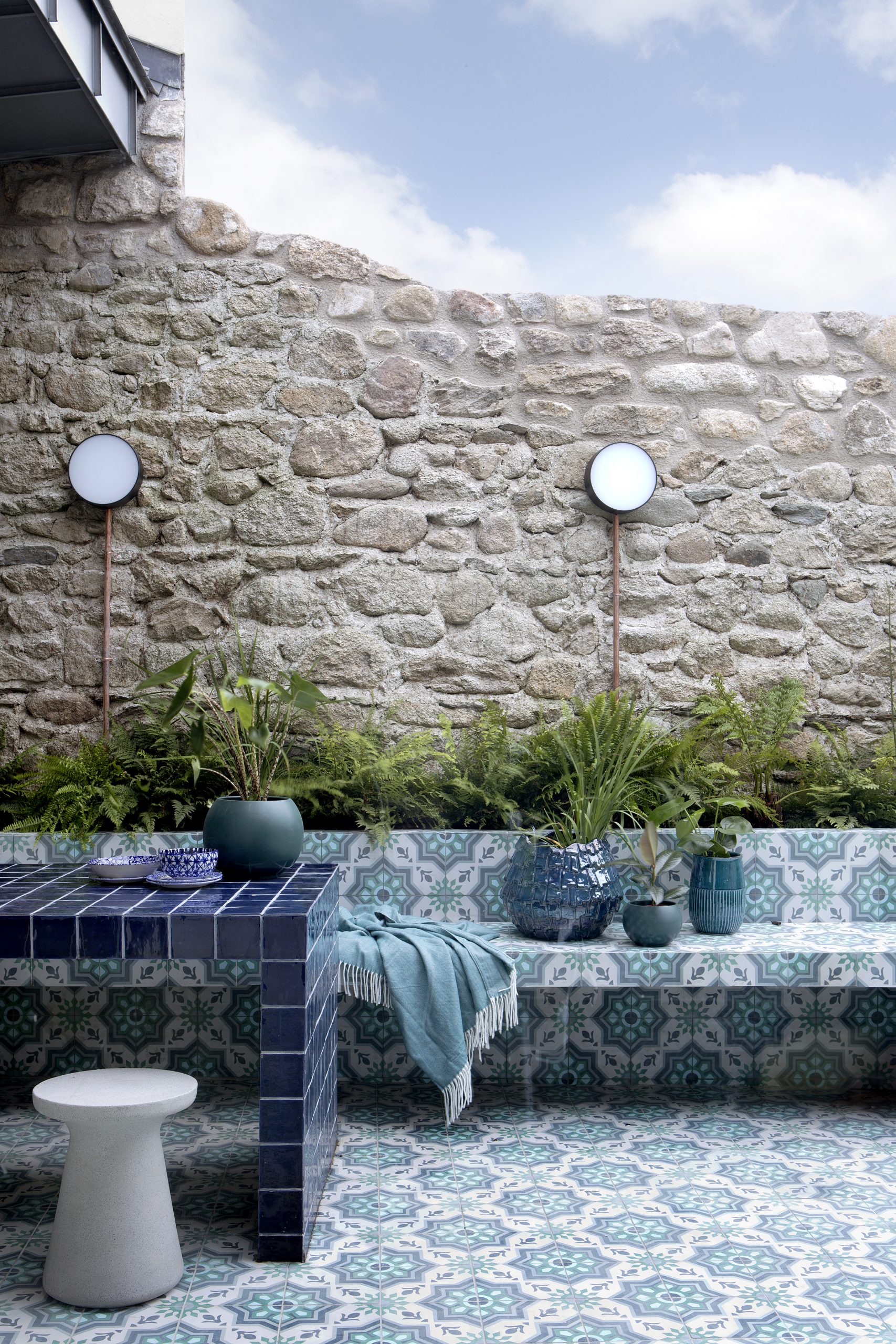
In this design, there is a sleek and seamless integration of the indoor and outdoor spaces. Ideal for small gardens, this space embraces tiled flooring throughout the modern garden.
To create more of an edge, the integrated tiled seating area creates the perfect spot for hosting garden parties and enjoying those magical al fresco nights.
19. Install an Outdoor Kitchen
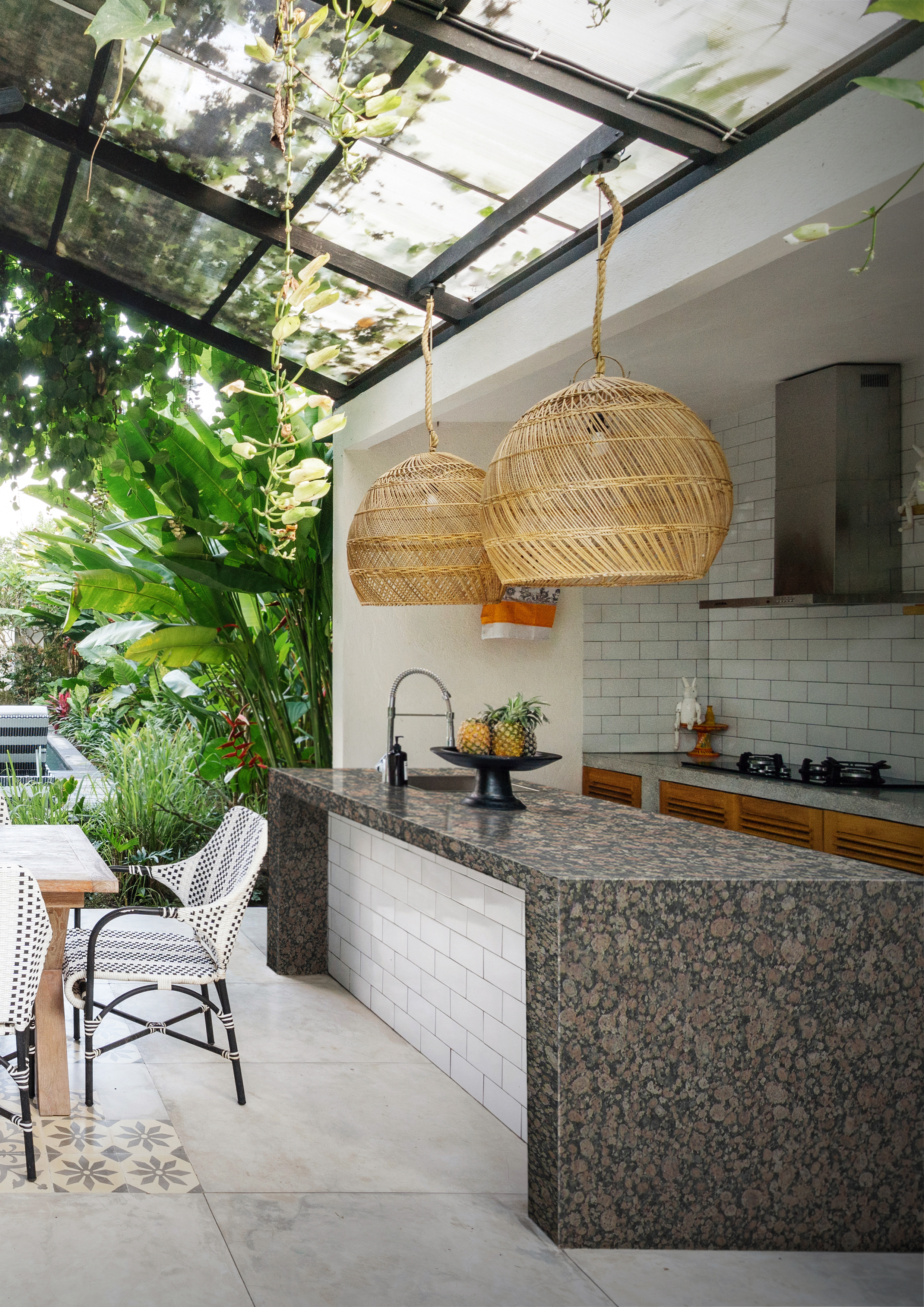
Outdoor kitchens are the perfect way to entertain guests and cook up a storm. "Creating outdoor kitchen/bar areas in the garden is really popular," says Garden & Camping's Design Specialist Laura Ayres. "It's such a great idea, as it brings a whole other element to your outdoor area. Integrating concrete worktops with built-in pizza ovens and optics for an at-home bar is the ultimate garden glow-up."
As for planning an outdoor kitchen, there are quite a few things you'll want to consider. "A key consideration is how the outdoor kitchen will fit into the existing garden," says Jonathan Stanley of Caesarstone. "Most will be next to or close to the house, but if you're planning to implement yours at the other end of the garden to maximise sunlight, for example, then it’s worth thinking about creating additional storage for kitchen essentials."
So, what are you waiting for? We think it's time to create your dream modern garden outdoor kitchen!
20. Create a Living Room Outside

A great way of bringing the indoors, outside is by creating a cozy outdoor living room.
"Outdoor living rooms are becoming increasingly popular and are a great way to make the most of your garden all year round," says Simon Hudson of luxury outdoor furniture company Oxley's. "There is now a huge range of outdoor furniture and accessories that have been designed specifically to create an indoor look while withstanding outdoor conditions."
Jonny Brierley of Moda Furnishings adds: "Space and shape are the first two things to consider when creating a space outside that can function as well as your interior. If you have a long, narrow garden, you may decide to zone the space, while wider gardens can benefit from access points across the back of the house."
Jonny suggests that you think about how you will utilize the space. He adds: "Perhaps you want an area for lounging in the sunshine or cosying up with throws on cooler evenings, or maybe you need a BBQ set-up. Make sure you know exactly what you want to use your garden for in the same way you would design rooms in your house for specific use."
We have a wealth of outdoor furniture ideas for small spaces to inspire your decorating style.
21. Create a Recessed Seating Area for a Cocooned Space

This cozy seating nook is cleverly hidden from the main patio area, as it sits just a few steps lower.
A perfect modern garden idea if you want a secluded space to escape to. Integrate recessed seating among planters, against walls, or wherever space allows for a more cocooned effect.
22. Install a Garden Room or Create a Guest House

Garden rooms are the perfect home extension without the additional fuss of actually dealing with the mess within your home.
You can turn the space into a guest bedroom, an office, a gym, or an additional space for your much-loved plants.
In this garden room design, its bright features create an inviting feel — touches of nature's greenery surround the white, adding to the peaceful atmosphere in this modern garden.
23. Create an Urban Garden

Find inspiration in this modern garden idea by embracing container gardening and bringing potted shrubs and plants to your urban space. If you're living in the city and want to be one with nature, this is the perfect way to do just that.
"Stick to either angular or round pots leads to a coherent finish, as does limiting the materials," says Tom Harris, author of Pots for All Seasons.
In this city home, Tom combined cordylines and phormiums with soft Japanese maples for a low-maintenance scheme.
24. Divide Your Garden
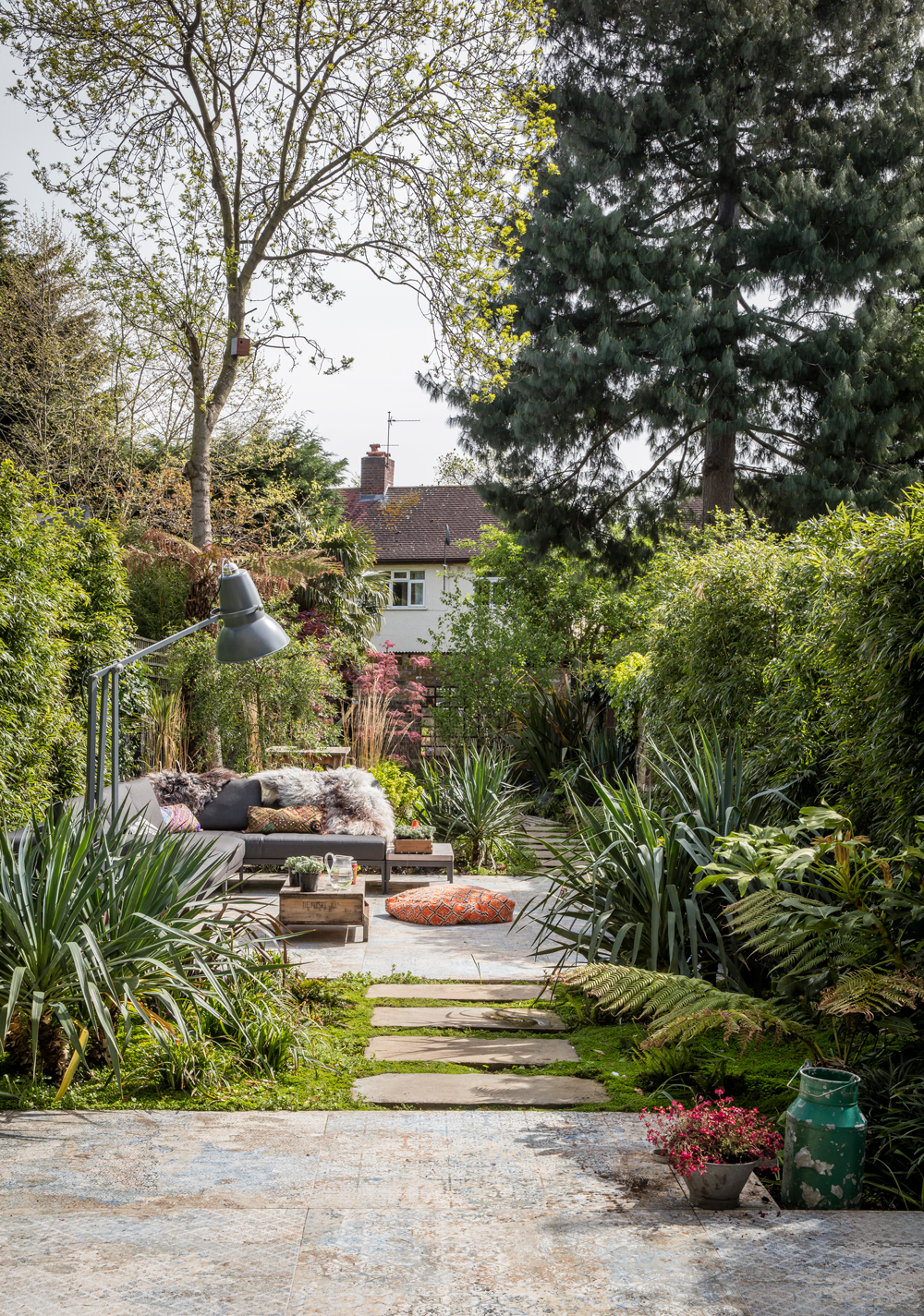
Dealing with a narrow garden? Creating split levels or different areas in your garden can create the illusion of a larger space. For example, on one side you can have the dining area, while on the other, a cozy nook and bench to allow guests to unwind amongst nature.
"If possible, you should try to define the space," says Juliette Thomas of luxury interiors brand Juliettes Interiors. "This could be with a shady pergola or contemporary garden screens, or something as simple as a large shade sail.
"To complete the look of an outdoor room, inject some personality, just as you would indoors, with patterned rugs and colourful cushions, elegant side tables or grand, oversized potted palms."
Size: 160 x 230 cm
Perfect to spruce up any outdoor living space — or indeed, anywhere inside, too — made of durable materials to withstand the elements and colors that won't fade in the sun.
25. Choose Poured Concrete for Lower Maintenance

Poured concrete offers a highly contemporary look, with the added bonus of being incredibly low maintenance.
Poured concrete patios at different levels make the most of this sloped garden (above) while also creating an interesting contrast to the wood decking areas.
26. Choose Brick or Stone for a Traditional Look
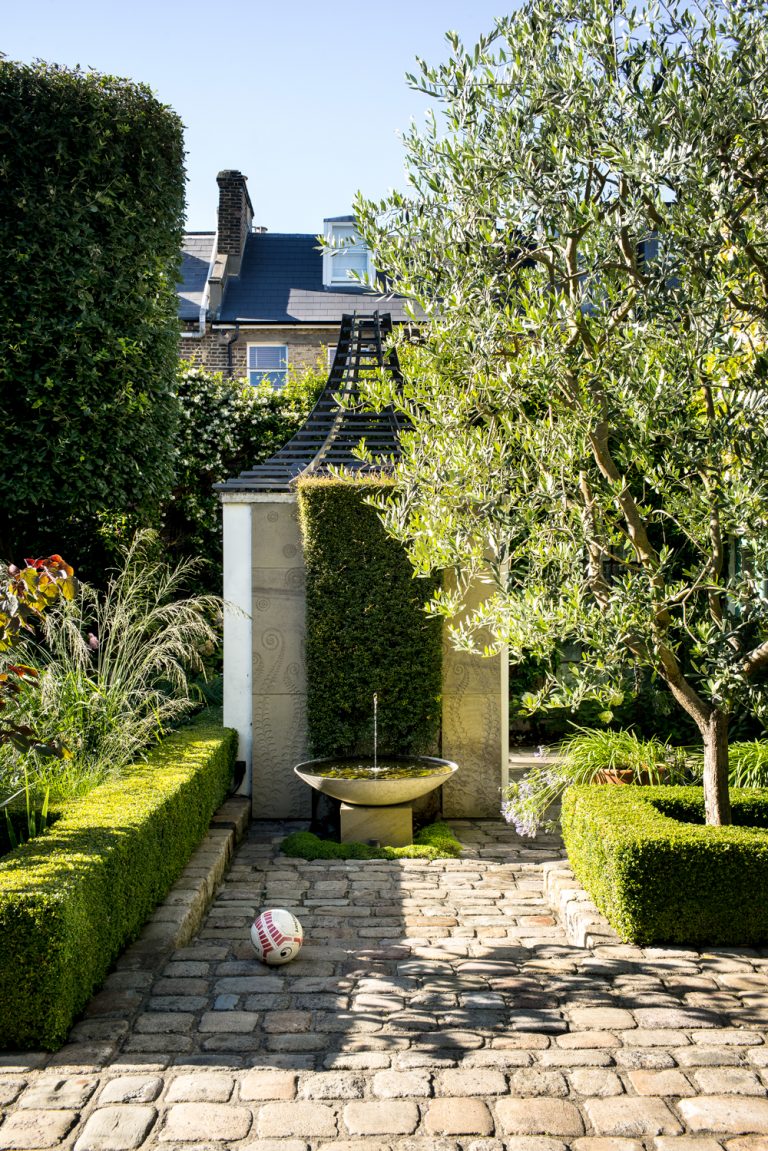
Want to bring a twist to your modern garden ideas? Stone cobbles will create a traditional, English-style garden that will certainly impress.
The cobbled look is a classic feature found in many homes in the UK and is a timeless design that can't go wrong. It's ideal for patio flooring and is relatively easy to maintain due to its durable and weather-resistant features.
"When creating a more traditional garden, opt for using stone where you can," says Garden and Camping Design Specialist Laura Ayres. "Every piece is slightly different in cut and color; it will fit together in its own unique way and provide you with a stunning backdrop to your garden."
27. Or Use Unexpected Materials to Create a Feature Wall

This vibrant feature wall at the Bacoc Hacienda in Mexico, designed by Reyes Ríos + Larraín Arquitectos, creates a warm contrast against the modern concrete main house.
Use a contrasting material, like red clay, copper, cement, wood cladding, tiles, or even moss, to create a minimalistic feature wall in your garden.
28. Install a Fireplace
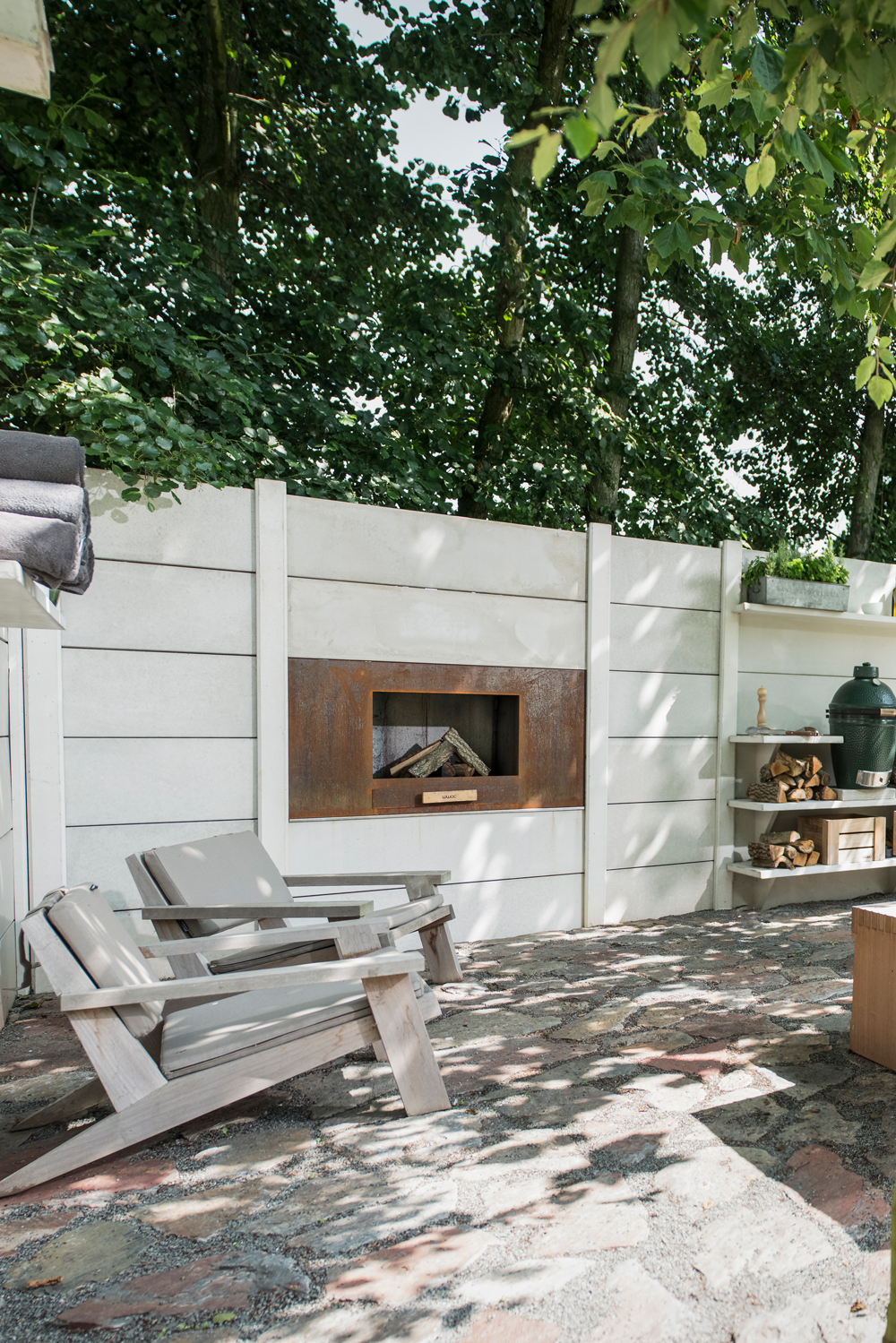
Oh, who doesn't just love to cozy up to an outdoor fireplace? A great modern garden idea that will create a focal point and gathering space for friends and family.
In the design above, the fireplace has been seamlessly designed within a wall that wraps around the garden. Close to the fireplace is open shelving where the homeowners can keep wooden logs, providing easy access.
Summer nights and al fresco dining just got a whole lot more exciting.
29. Or a Fire Pit
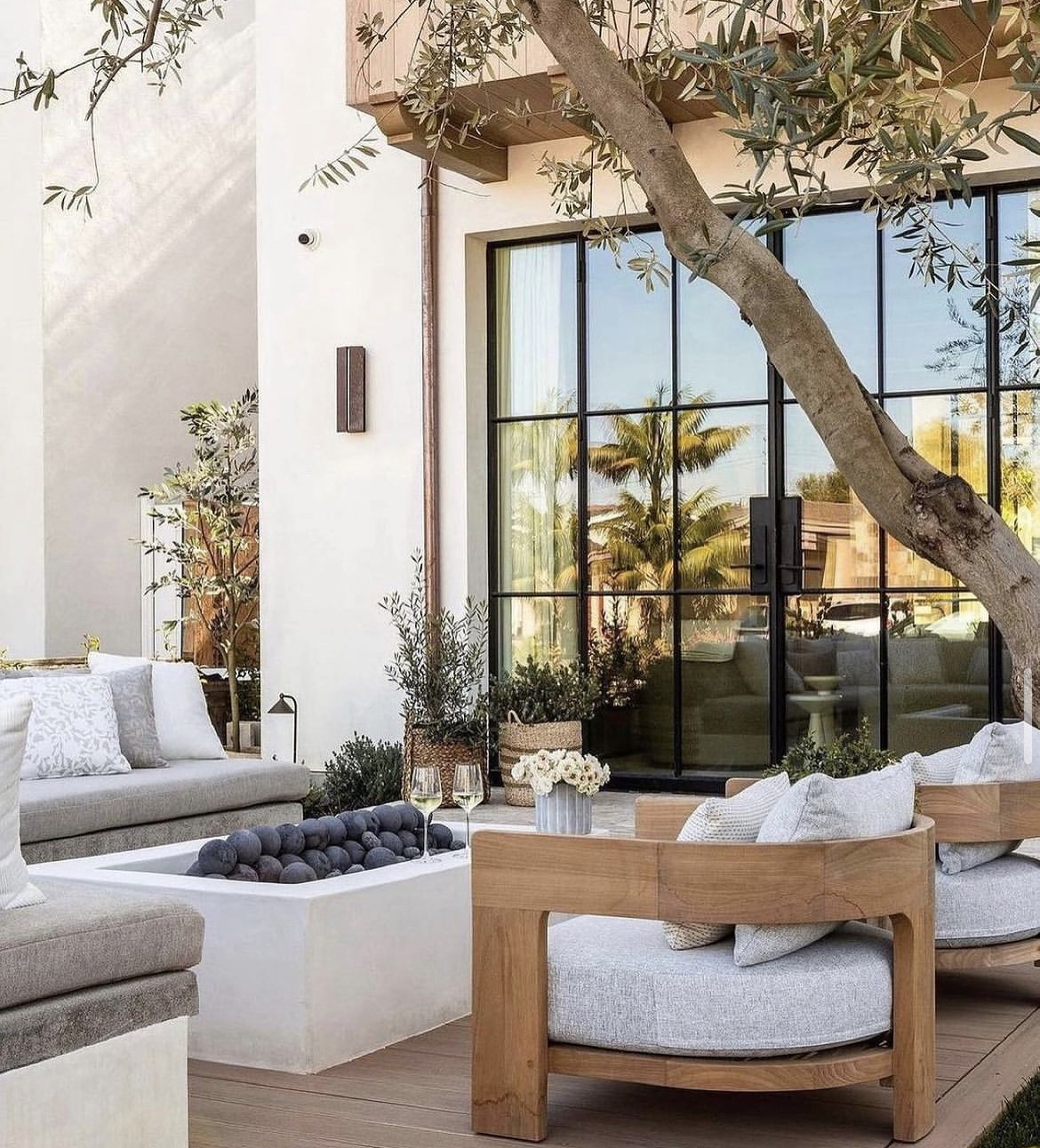
You can install a fire pit for the same effect as a fireplace, but with
Portable fire pits also offer flexibility to move the warmth wherever you most need it.
This geometric fire pit by VonHaus boasts a 5/5 star rating after over 250 reviews and would suit any outdoor dining aesthetic. Bring on late hosting and marshmallow toasting.
30. Add a Water Feature
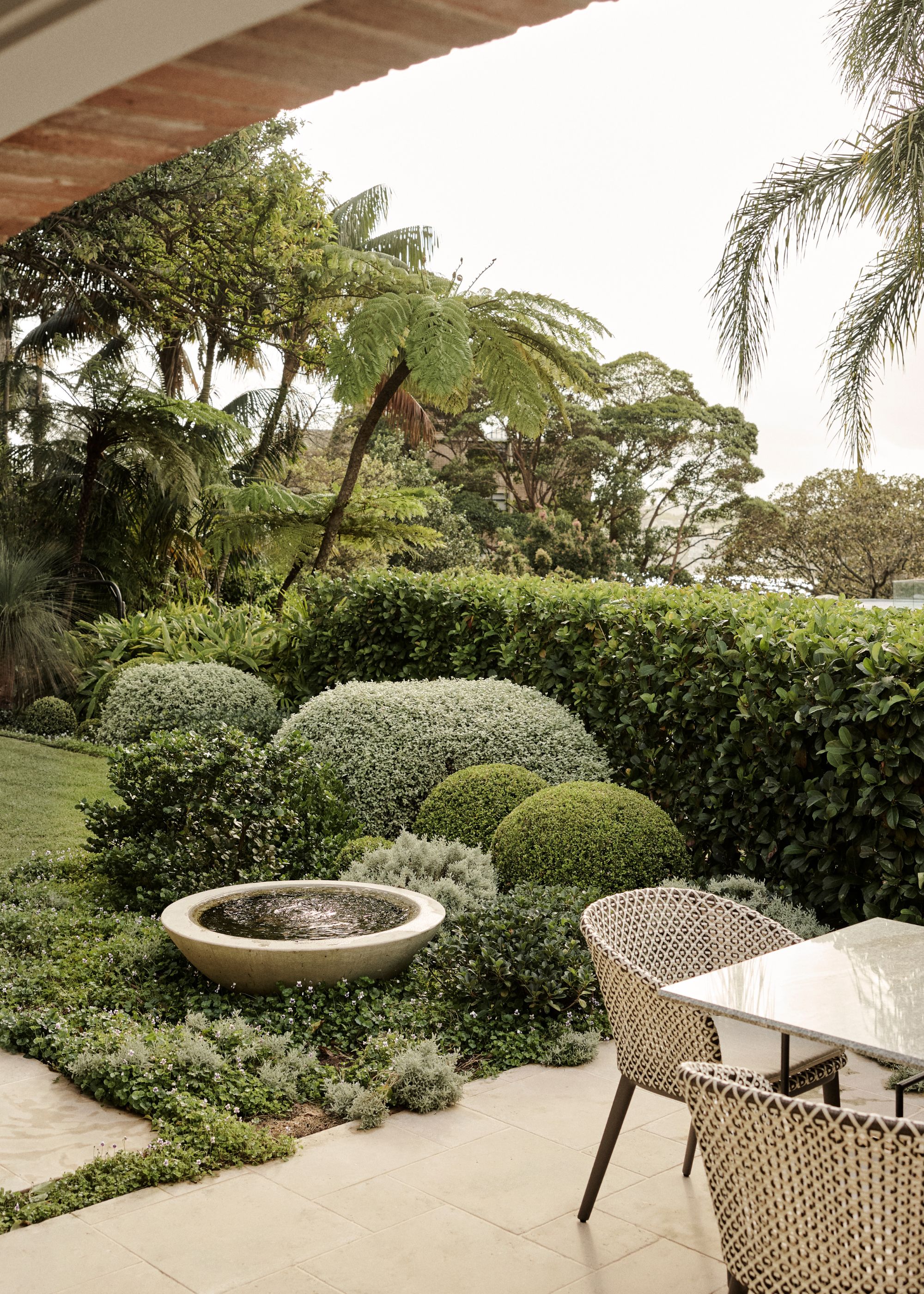
Designed by Marylou Sobel Interior Design Pty Ltd, this simple, yet elegant water garden idea has a way of elevating the space and creating a calming ambiance during summer nights.
Trimmed hedges and plants surround this stunning stone water fountain, adding a lovely break and contrast amidst the plants.
31. Add Height With Raised Beds

For a cute flower bed idea, you can opt for raised beds. They're a great way to add height as well as attention to your beautiful summer blooms.
This idooka Rectangular Plant Stand from Amazon is ideal for small gardens and can be used to plant vegetables, flowers, and herbs. If your modern garden is limited in space and you're working off your balcony, this raised bed will undoubtedly be the perfect fit.
32. Choose Unique Furniture Materials
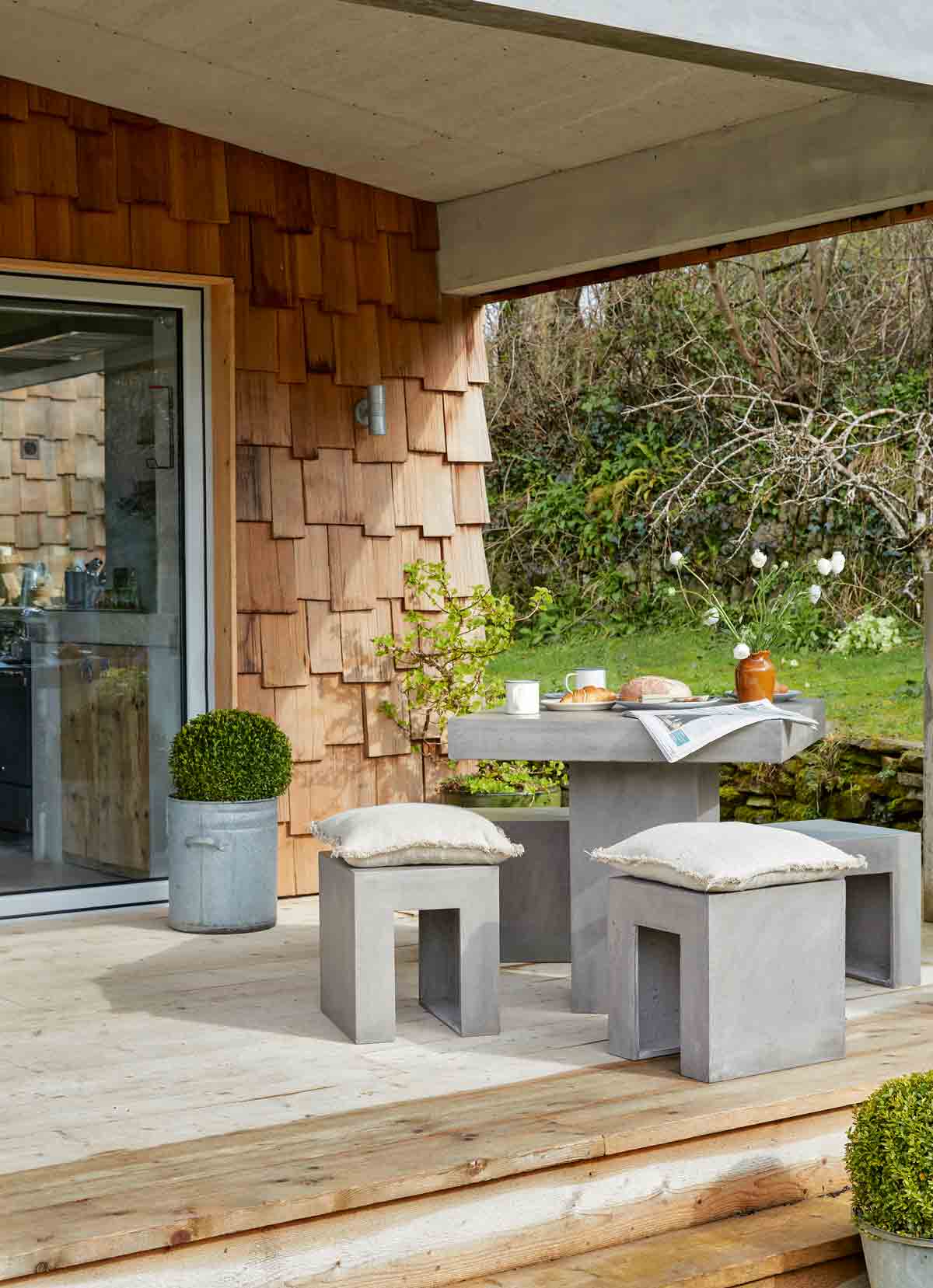
If you're looking for out-of-the-box outdoor furniture ideas, then concrete furniture may just be your saving grace.
Durable, easy to maintain, and undoubtedly chic, concrete furniture creates a modern and seamless look in a garden. Take this Pavilion Chic Toria Side Table — its beautiful design creates a statue-like figure that adds dimension and interest to a modern garden.
33. Entertain With an Outdoor Cinema
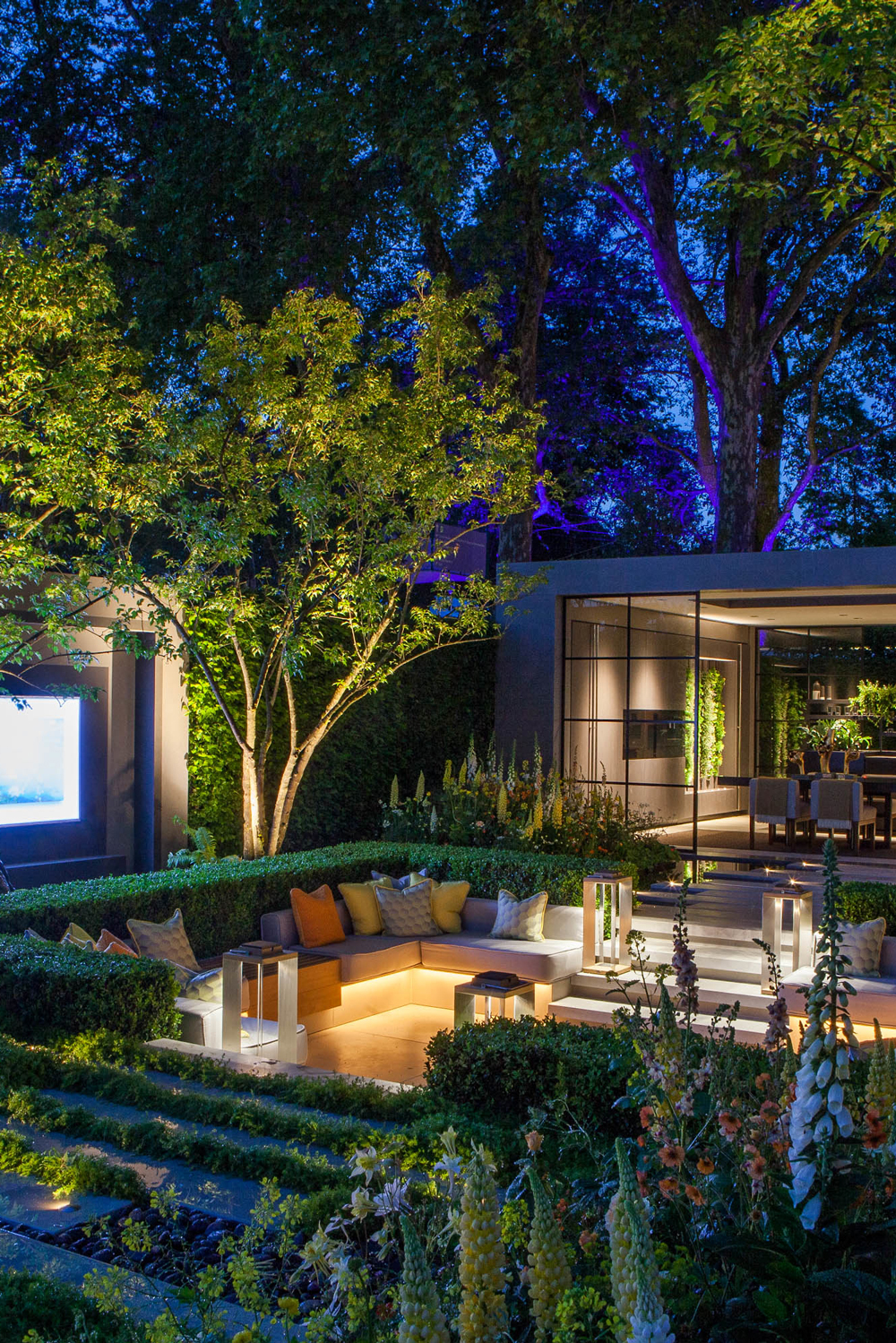
Oh, how wonderful to see your favorite actor on a big screen, and best of all? It's from the coziness of your own home. Backyard movie night is the ultimate summer treat.
Transformed by lights into a starry stage set at night, Sally Storey of John Cullen says, "Light key features, such as trees, to show off their textures and colors, and also steps to guide you safely."
There's a wall-mounted flat-screen TV under a nearby covered porch area, offering the ultimate outdoor cinema setup — perfect for sporting events or movie nights. Cottage-style planting softens the state-of-the-art technology.
34. Add Pendant Lights
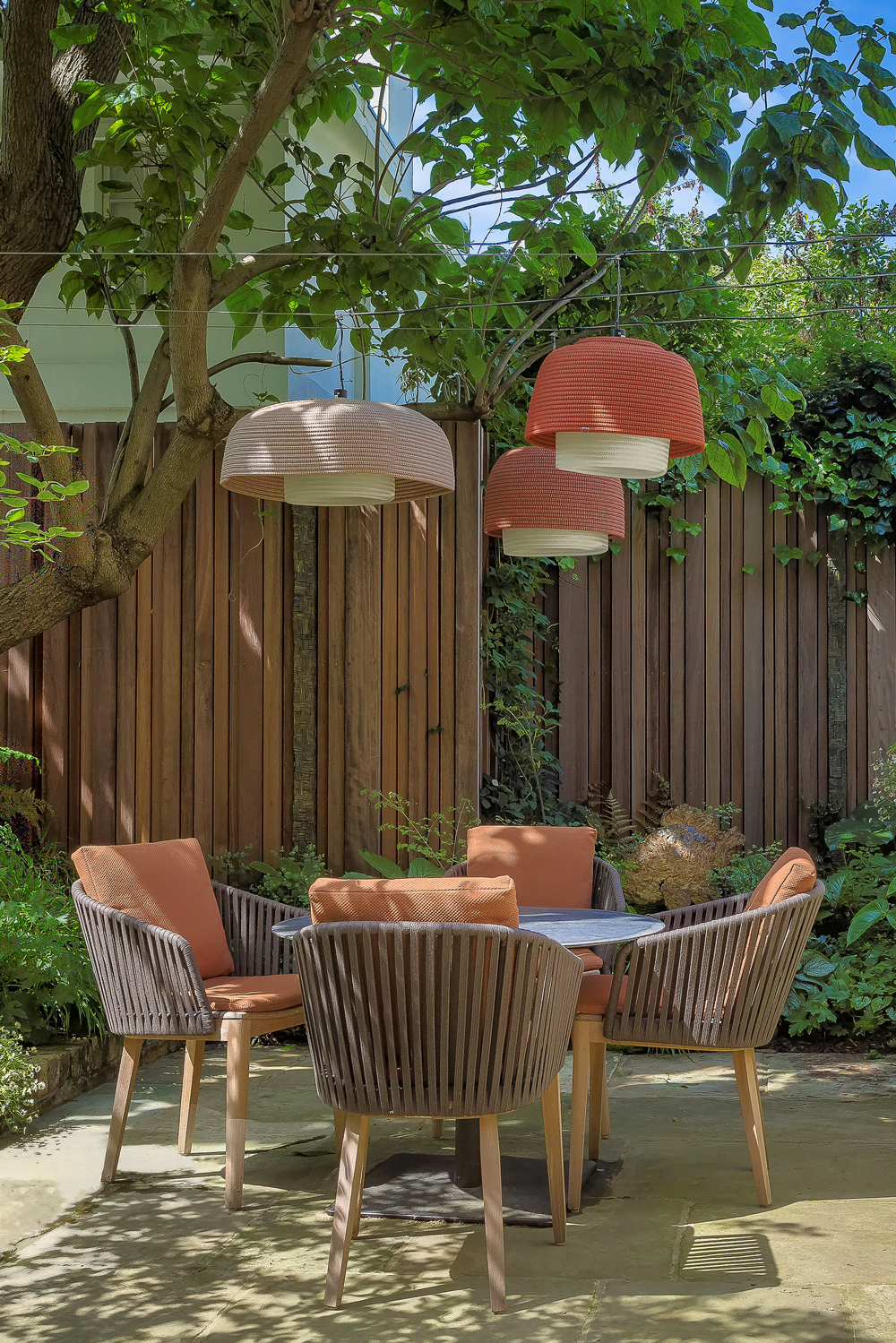
The best garden lighting idea? Add a stylish pendant light above your dining area.
"Lighting is not only one of the most important elements inside the home, it’s just as important outside too," says Ian Cameron of bespoke sculptural lighting brand Cameron Design House.
Ian continues: "Ambience is key with lighting playing a crucial role in helping to set the mood. In the garden, opt for a design that complements nature and blends seamlessly into its surroundings."
35. Add a Built-in Hot Tub
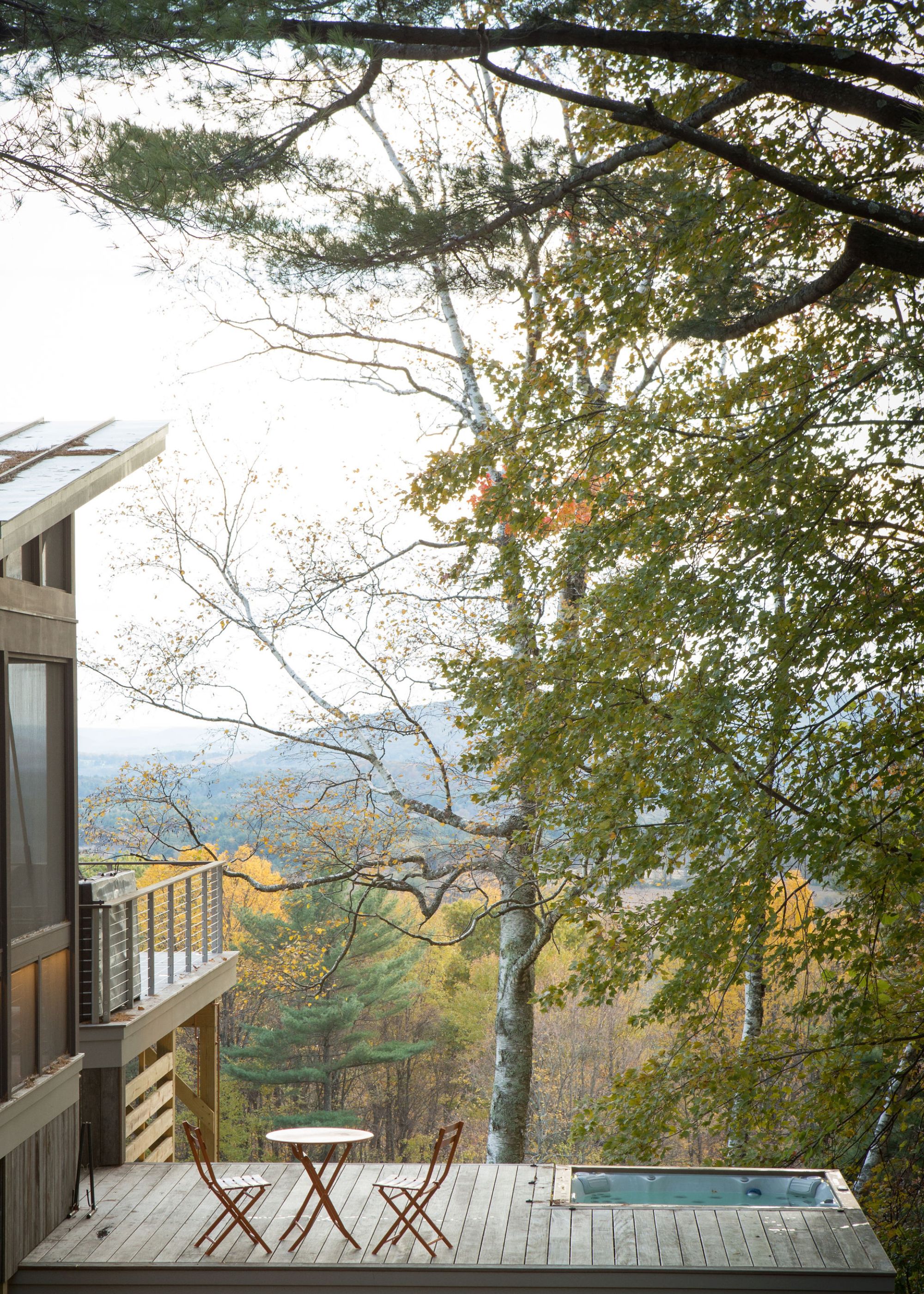
Designed by Clark Green + Bek ,this modern garden has a chic, yet small hot tub installed onto its deck. The best part? There is a view that is truly irreplaceable.
As designed above, to enhance your modern garden, you could also add patio furniture that will allow you to wine and dine after a long dip in the hot tub. What more could you want, am I right?
36. Soften Hard Angles With Wild Plants

Contrast and complement modern architecture with loose foliage and wilder plants for a less structured look.
In this modern garden design by Helene De Witte, weathered clay pavers were used that recall historic gardens, alongside more rigid, formal structures.
To loosen the angularity, the natural sways of nature, with clever planting choices, work wonders.
37. Space Your Paving to Allow Nature to Flourish

Hardscaping is becoming greener with crazy paving or spaced pavers that allow rainwater to seep into the ground rather than run off into drains.
In this small, urban garden, designer Stuart Craine used spaced concrete beams to create a path that allows plants, such as mind-your-own-business, to creep into the crevices.
This looser approach to paving softens the look of a path, creates better drainage, and provides habitats for wildlife, too.
38. Got a Basement? Incorporate Glass Skylights Into the Flooring
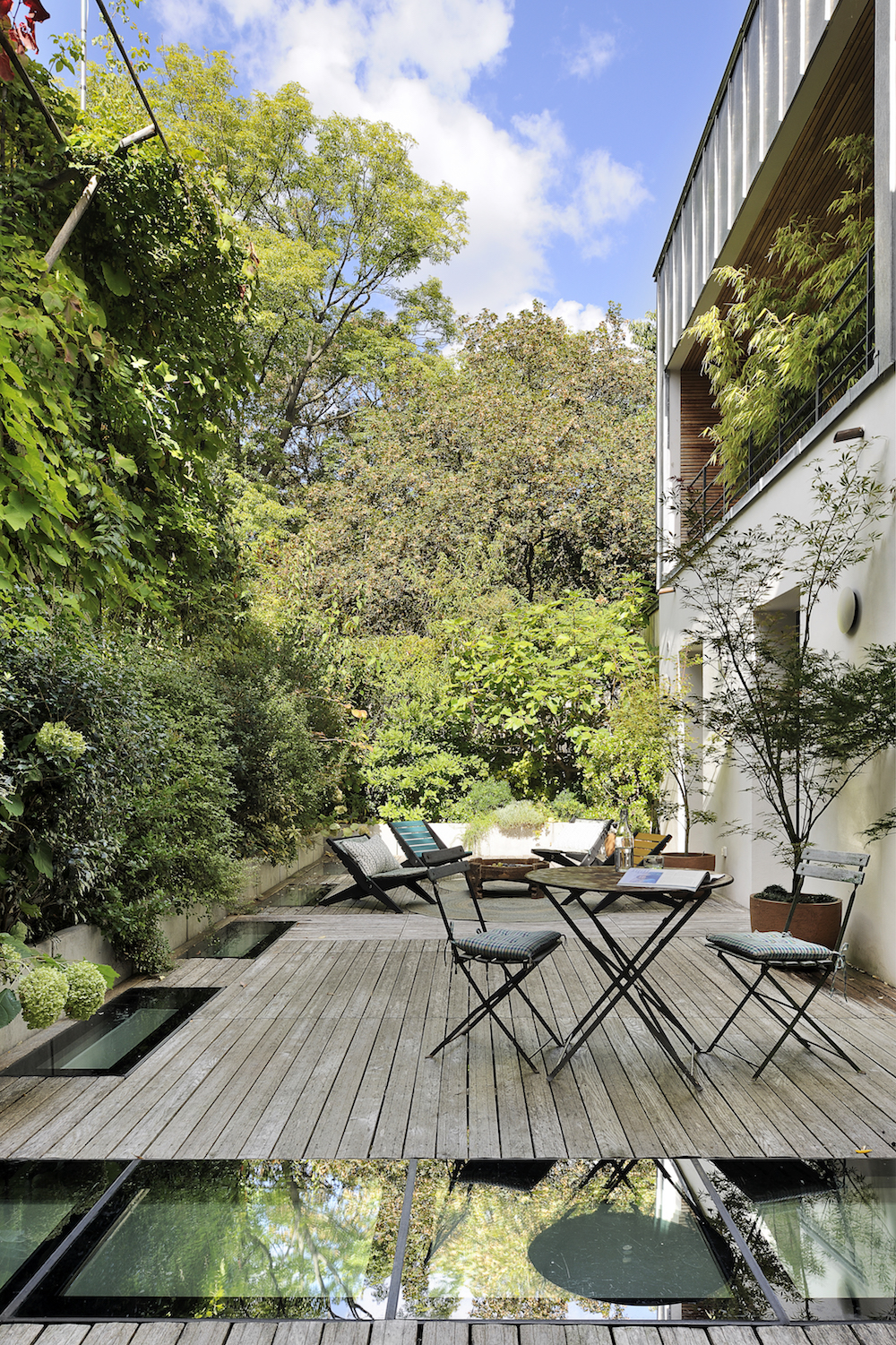
One of the coolest deck ideas — sleek light wells built into the wooden flooring channel extra daylight into the basement below while creating a stunning modern feature in the garden space above.
The generously planted surrounding space leans into nature and also provides added privacy in a busy district.
FAQs
How Do I Make a Garden Look Modern?
Clean lines, interesting foliage and a limited color palette gives a garden a modern look. Instead of blousy blooms in sugary pinks and florals that your grandma may love, consider ornamental grasses, sedges and mounding groundcovers, mixed with architectural plants, such as phormium, cordyline or yucca and those with large or textured leaves and tall flower stems, such as alliums or astilbe. These linear shapes and restrained color palettes provide a modern aesthetic.
What Are the Three Golden Rules of Modern Garden Design?
According to Manoj Malde, the three golden rules of garden design are:
"First, design the garden as a whole, not as individual areas," he says. "Limit your hardscape materials to a maximum of three and keep them a neutral color. And create repetition and rhythm in the landscape by repeating planting and color through the whole garden so that your eye is led through it."
Before deciding which modern garden ideas are best for you, consider how much maintenance you are prepared to do, how much time you would like to spend outside in your backyard, and whether it's feasible, along with which of the various elements most suit your lifestyle, budget, and values.
You may be interested in taking note of the latest garden trends for 2025 to help with your design ideas.







